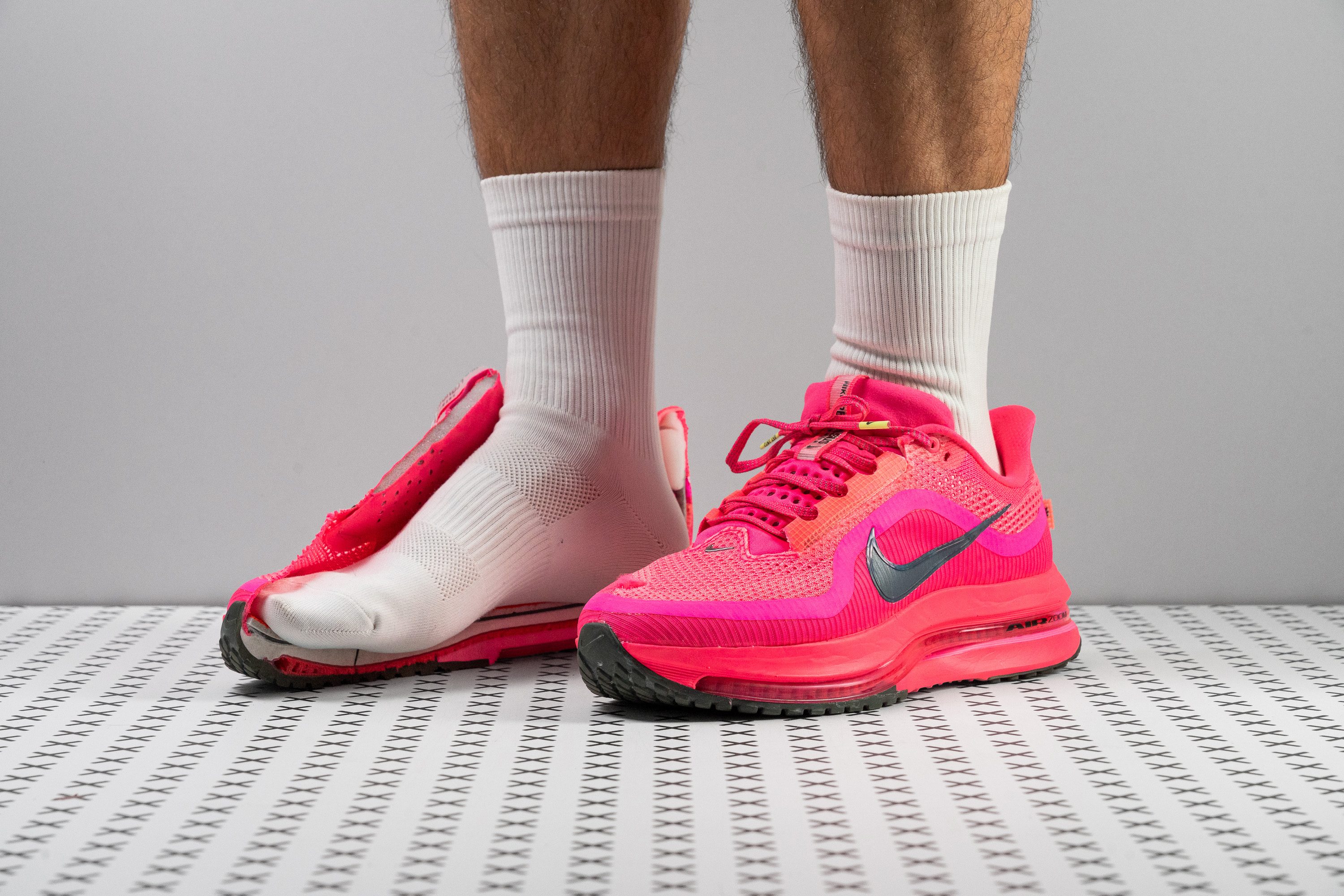Our verdict
- Top pick in best Nike running shoes
- Top pick in best Nike shoes for walking and standing all day
Pros
- Triple-layer, spring-like midsole
- Handles long runs and tempo efforts
- Sublime step-in comfort
- Incredibly fun to ride
- Amazing build quality
- Knit upper offers top breathability
- Visually stunning from every angle
- 360-degree reflectivity
- Finally a max-cushioned Pegasus!
Cons
- Narrow fit excludes many runners
- Needs to lose some weight
- High price
- It's noisy!
Audience verdict
- Top 5% most popular running shoes
Comparison
The most similar running shoes compared
+ + Add a shoe | |||||
|---|---|---|---|---|---|
| Audience score | 83 Good! | 91 Superb! | 92 Superb! | 87 Great! | |
| Price | £190 | £135 | £160 | £100 | |
| Pace | Daily runningTempo | Daily running | Daily running | Daily running | |
| Shock absorption | High | High | High | Moderate | |
| Energy return | High | Moderate | Low | Low | |
| Traction | High | Moderate | High | Moderate | |
| Arch support | Neutral | Neutral | Neutral | Neutral | |
| Weight lab Weight brand | 10.9 oz / 308g 10.9 oz / 309g | 10.5 oz / 298g 11.5 oz / 325g | 9.9 oz / 281g 10.2 oz / 289g | 10.4 oz / 295g 10 oz / 283g | |
| Drop lab Drop brand | 11.8 mm 10.0 mm | 13.9 mm 10.0 mm | 12.7 mm 6.0 mm | 12.3 mm 10.0 mm | |
| Strike pattern | Heel | Heel | Heel | Heel | |
| Size | Slightly small | True to size | Slightly small | True to size | |
| Midsole softness | Soft | Soft | Soft | Soft | |
| Difference in midsole softness in cold | Small | Small | Small | Normal | |
| Toebox durability | Bad | Decent | Decent | Decent | |
| Heel padding durability | Good | Good | Good | Good | |
| Outsole durability | Decent | Decent | Good | Good | |
| Breathability | Breathable | Moderate | Moderate | Moderate | |
| Width / fit | Narrow | Medium | Medium | Narrow | |
| Toebox width | Narrow | Narrow | Medium | Medium | |
| Stiffness | Stiff | Moderate | Moderate | Moderate | |
| Torsional rigidity | Stiff | Stiff | Stiff | Stiff | |
| Heel counter stiffness | Stiff | Moderate | Stiff | Moderate | |
| Rocker | ✓ | ✓ | ✓ | ✗ | |
| Heel lab Heel brand | 42.8 mm 45.0 mm | 42.5 mm 45.0 mm | 44.1 mm 44.0 mm | 37.6 mm 35.0 mm | |
| Forefoot lab Forefoot brand | 31.0 mm 35.0 mm | 28.6 mm 35.0 mm | 31.4 mm 38.0 mm | 25.3 mm 25.0 mm | |
| Widths available | Normal | NormalWideX-Wide | NormalWide | NormalWideX-Wide | |
| Orthotic friendly | ✓ | ✓ | ✓ | ✓ | |
| Season | SummerAll seasons | All seasons | All seasons | All seasons | |
| Removable insole | ✓ | ✓ | ✓ | ✓ | |
| Ranking | #262 Bottom 29% | #25 Top 7% | #16 Top 5% | #166 Top 45% | |
| Popularity | #15 Top 5% | #8 Top 3% | #132 Top 36% | #78 Top 22% |
Who should buy
We tested the Nike Pegasus Premium to its limits and found that it's:
- A true supertrainer packed with sky-high bounce and high-octane fun.
- Built for runners chasing cutting-edge tech.
- A great option for those craving an Alphafly-style ride in a daily trainer setup.
- Tailored for narrow-footed runners wanting a cloud-soft, breathable knit upper like few others.
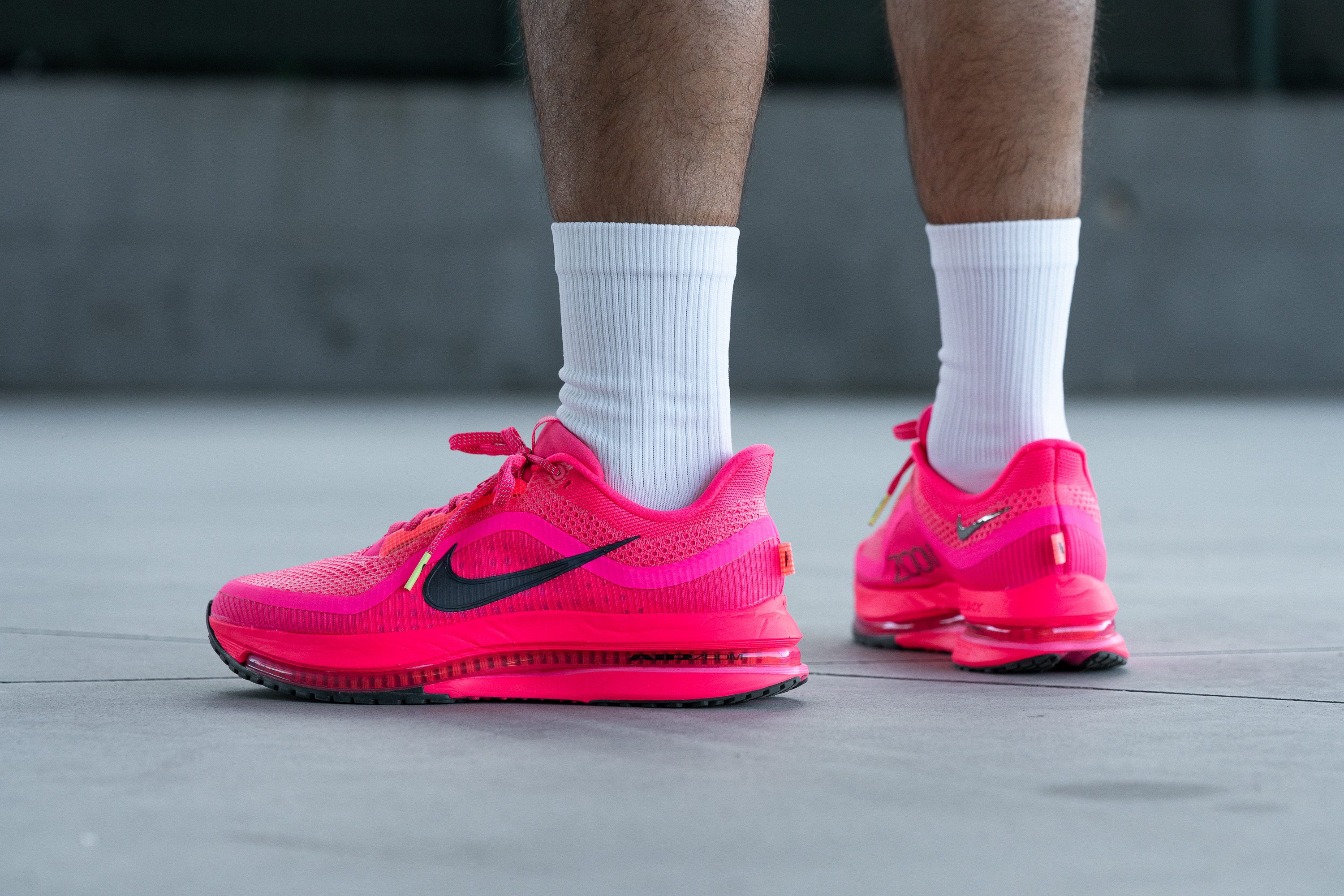
Who should NOT buy
The Pegasus Premium is a polarising supertrainer that, in our view, won’t suit every runner. We found it significantly heavier than alternatives like the ASICS Superblast 2 and Hoka Mach X 2—both offering similar energy return in a much lighter build.
We also found the narrow fit quite limiting, and we believe those needing more space should check the more budget-friendly Adidas Adizero EVO SL. It still offers a performance-ready fit but better suited for those with average feet.
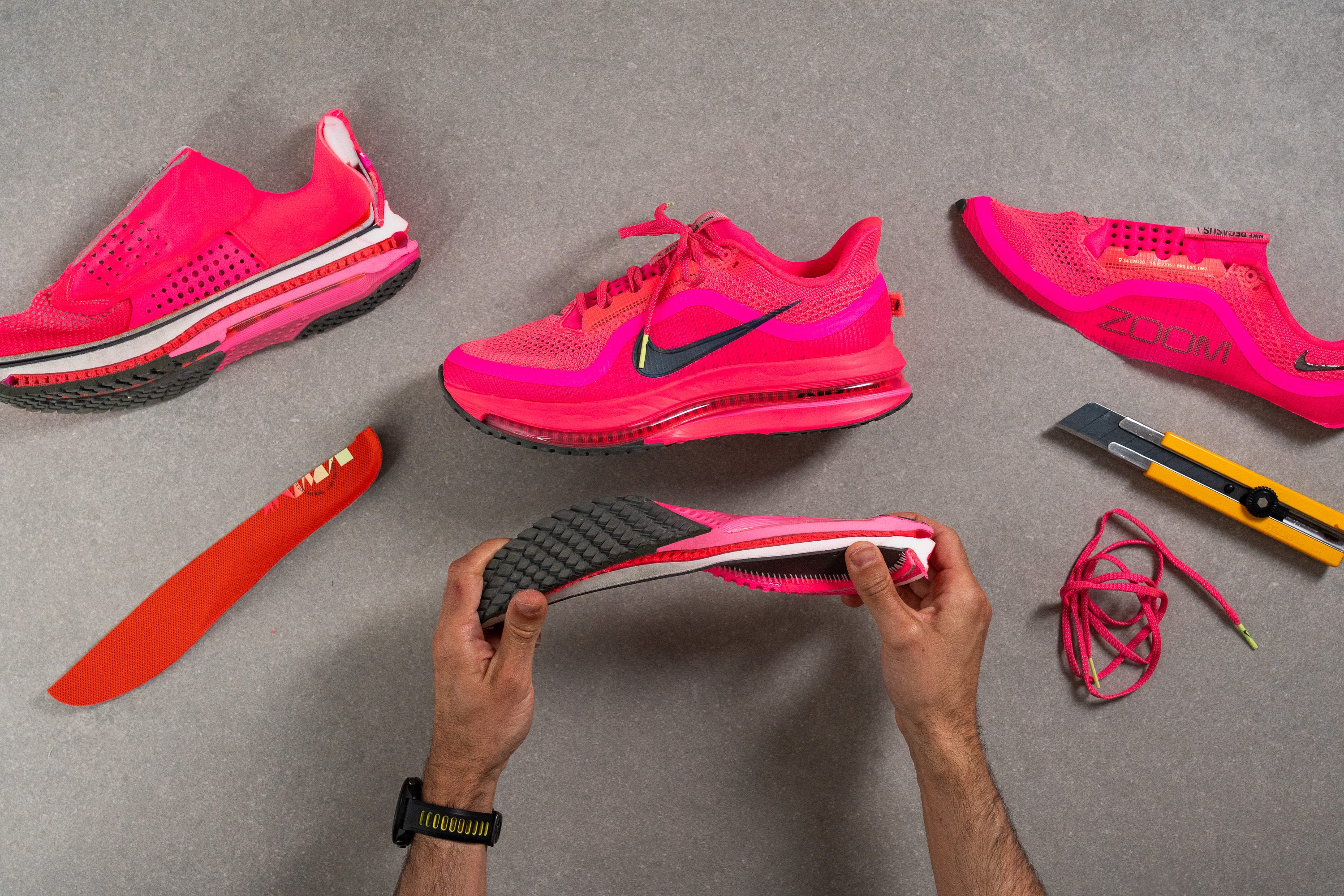
Lastly, the steep price tag might be tough to swallow. If that’s your case, the Zoom Fly 6 or Vomero 18 are better-value options from Nike.
Cushioning
Shock absorption
Shock absorption is absolutely massive in the Pegasus Premium, but honestly, how could it not be? The midsole is huge and packed with top-tier tech like ZoomX and Air Zoom. So hitting 155 SA in the heel and 136 SA in the forefoot felt expected, even if those numbers are anything but ordinary.
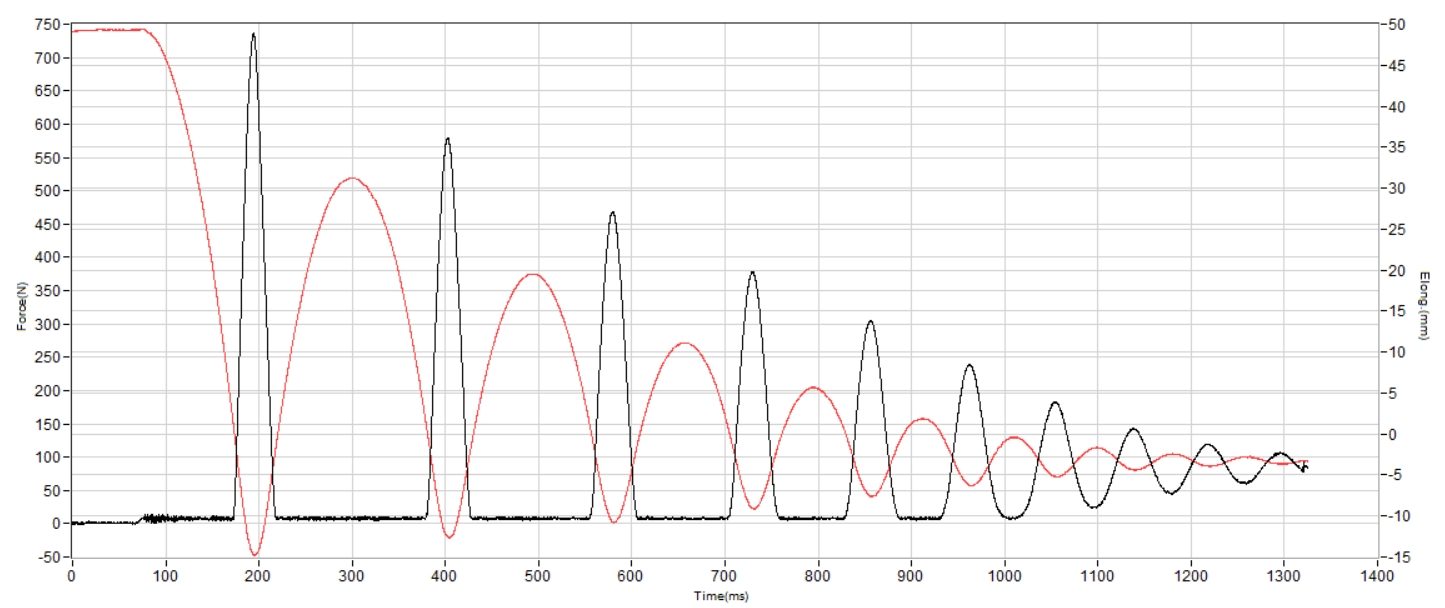
| Pegasus Premium | 155 SA |
| Average | 129 SA |
Energy return
The midsole of the Pegasus Premium was one of the most intriguing (and cool) designs we’ve seen in the lab, combining three layers: ZoomX, ReactX, and a full-length Air Zoom unit. And it performed well.
While 67.3% isn’t in supershoe territory, we expected that. After testing hundreds of shoes, we’ve learned how energy return behaves, and when you include a durability-focused foam like ReactX, it’s clear the bounce won’t match supershoe levels.
| Pegasus Premium | 67.3% |
| Average | 58.5% |
Heel stack
The Nike Pegasus Premium features a skyscraper-high 42.8 mm stack height, joining the supertrainer club with max cushioning that delivers explosive bounce on every stride.
We found three stacked layers—ZoomX, ReactX, and a full-length Air Zoom unit. Of course, the shoe delivers absolutely zero ground feel in this mega-cushioned setup. For heel strikers needing max impact protection, this is their dream Pegasus.
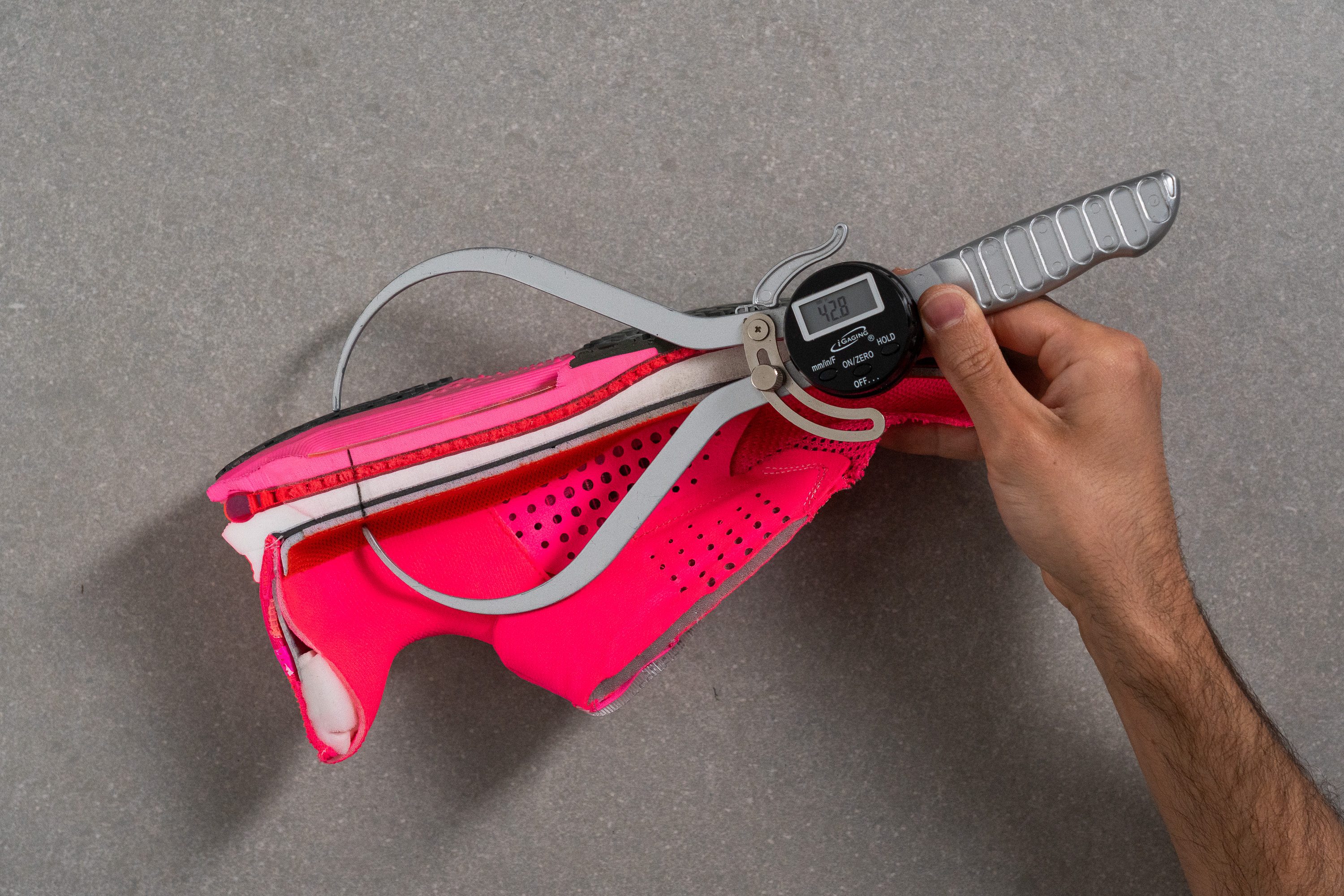
| Pegasus Premium | 42.8 mm |
| Average | 34.7 mm |
Forefoot stack
The forefoot is also quite impressive, going over 31.0 mm and delivering plush, long-distance-ready cushioning for midfoot and forefoot strikers.
For context, the Nike Pegasus Plus hits 33.0 mm in the heel—that’s why we found the Pegasus Premium’s maximalist design far more suitable for long runs.
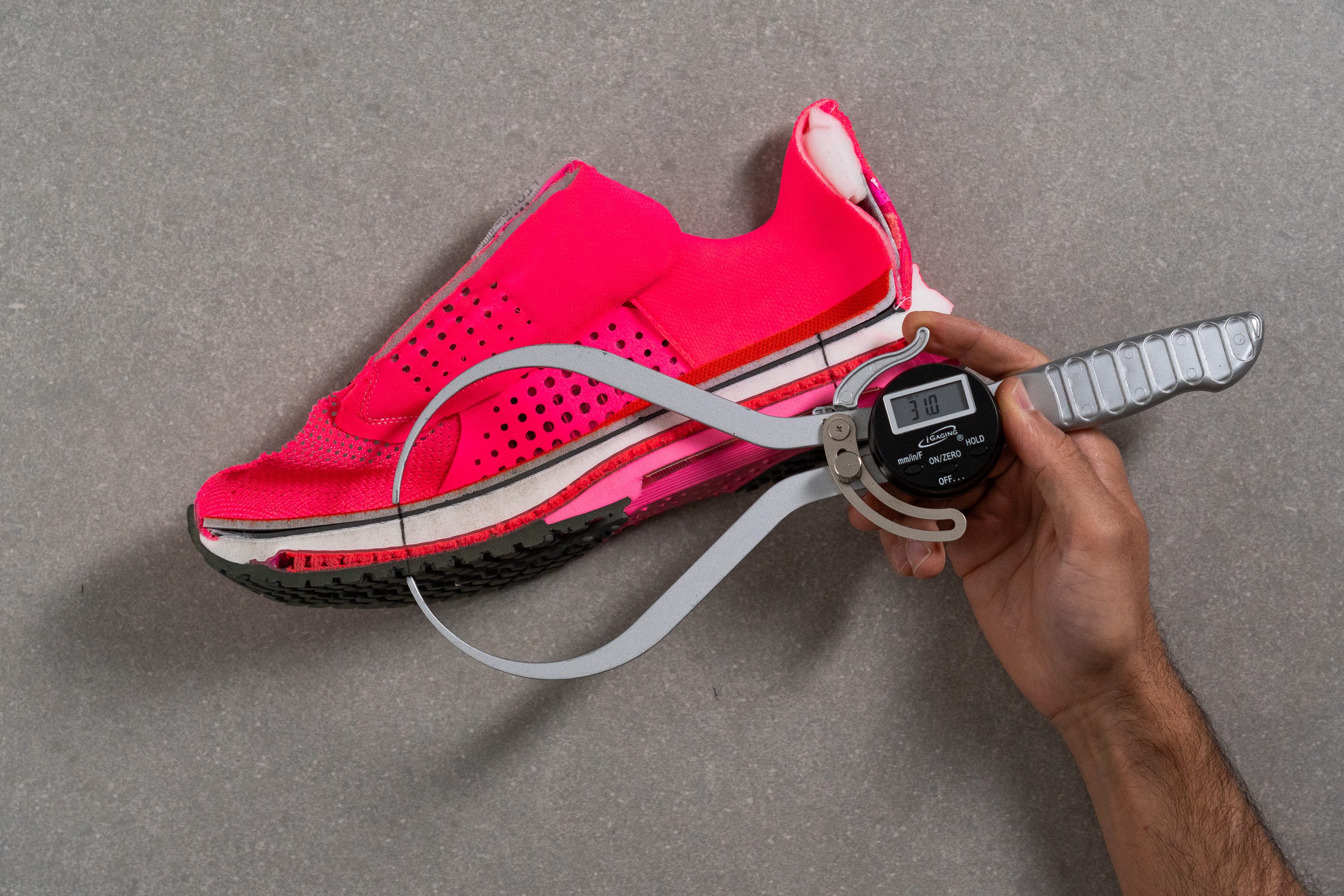
| Pegasus Premium | 31.0 mm |
| Average | 26.1 mm |
Drop
Nike claims an official 10 mm drop, yet we measured 11.8 mm. That's a heel-striker-friendly setup that works well for most runners. However, some forefoot strikers may prefer a less steep supertrainer like the New Balance FuelCell SuperComp Trainer v3.
Also, this sliced-shoe photo clearly shows the triple combo powering the Pegasus Premium’s ride: white ZoomX, vibrant-pink ReactX, and the full-length Air Zoom unit sandwiched in between.
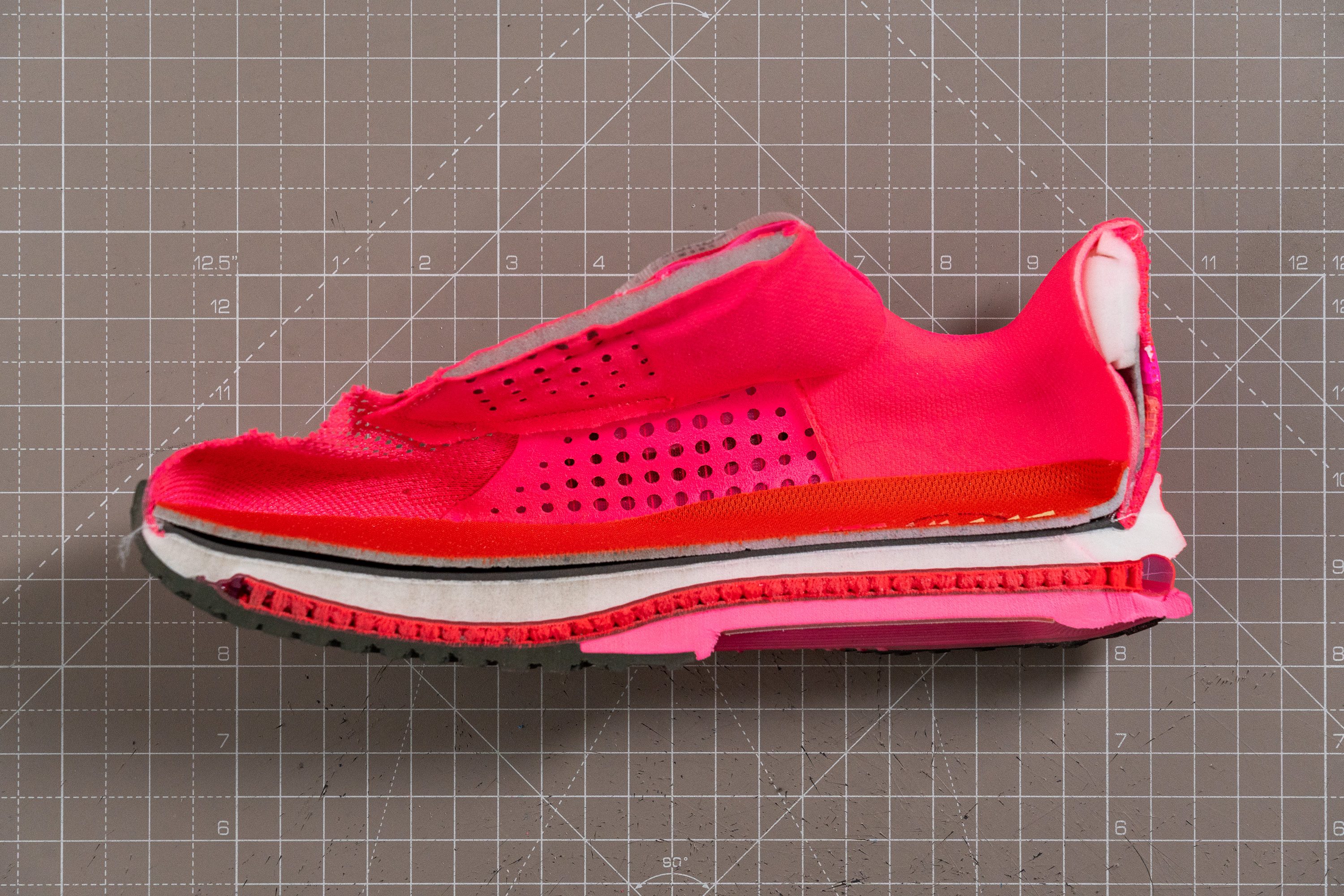
| Pegasus Premium | 11.8 mm |
| Average | 8.6 mm |
Midsole softness
Sporting “Premium” in the name, it was clear to us that it had to include ZoomX as the top-layer foam—closer to the foot for that max-bounce feeling we all love since Nike launched the Vaporfly.
However, this specific formulation of ZoomX isn’t ultra-soft. We measured 18.5 HA in our durometer, giving it a balanced feel rather than a marshmallow-plush one. That choice makes sense, especially considering the shoe’s sky-high stack height.
But what type of ZoomX is this? As we showed in our foams guide, Nike adjusts the ZoomX formula depending on the shoe’s purpose—balancing energy return and durability.
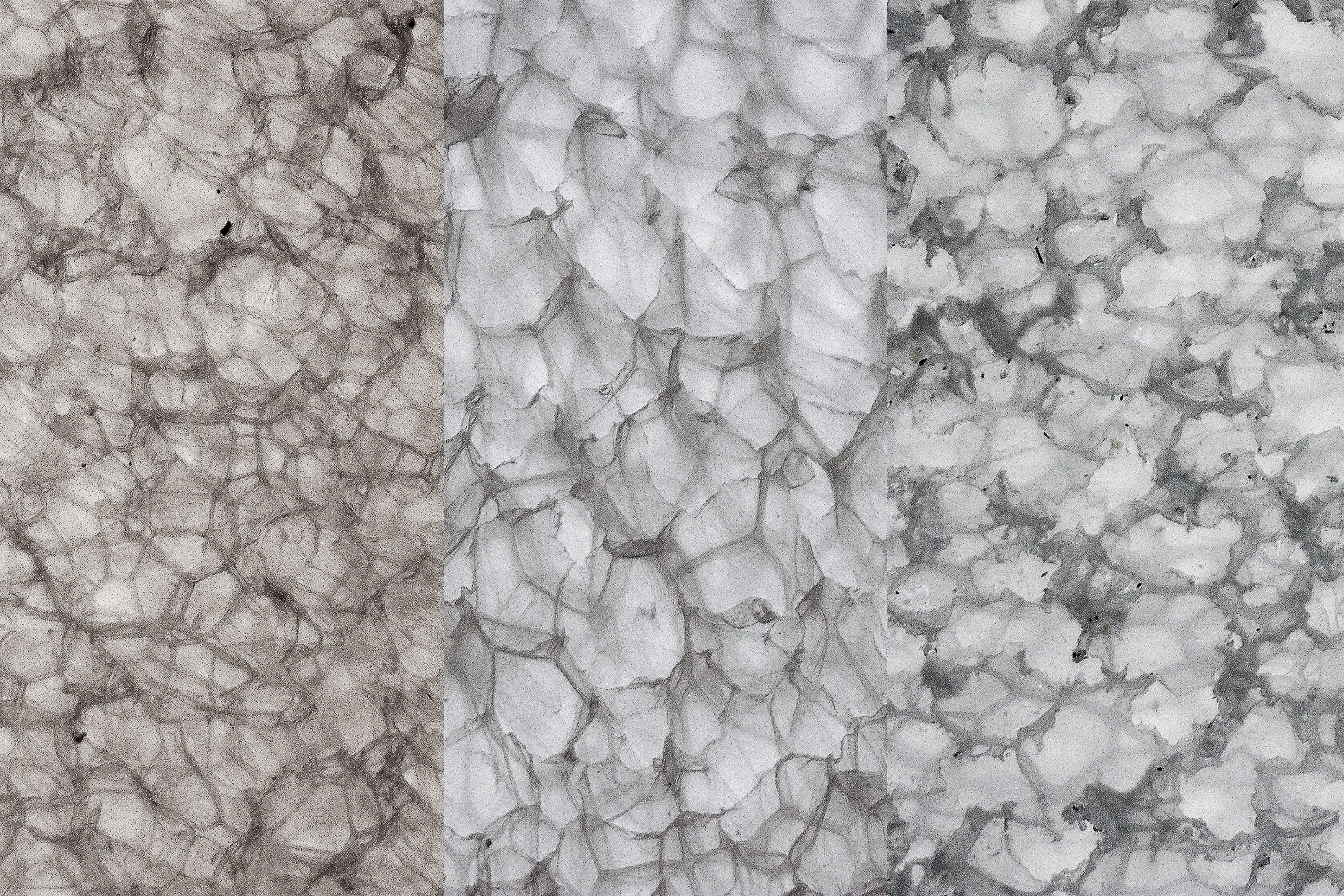
Let’s break down three samples we tested under the microscope:
- Alphafly 3 (left): Large, airy cells with ultra-thin walls—perfect for elite racing and explosive propulsion.
- Pegasus Premium (centre): Tighter, denser pattern than the Alphafly, but still more airy than the Zoom Fly 6.
- Zoom Fly 6 (right): Small, compact cells with thick walls. Offers less bounce but much better durability.
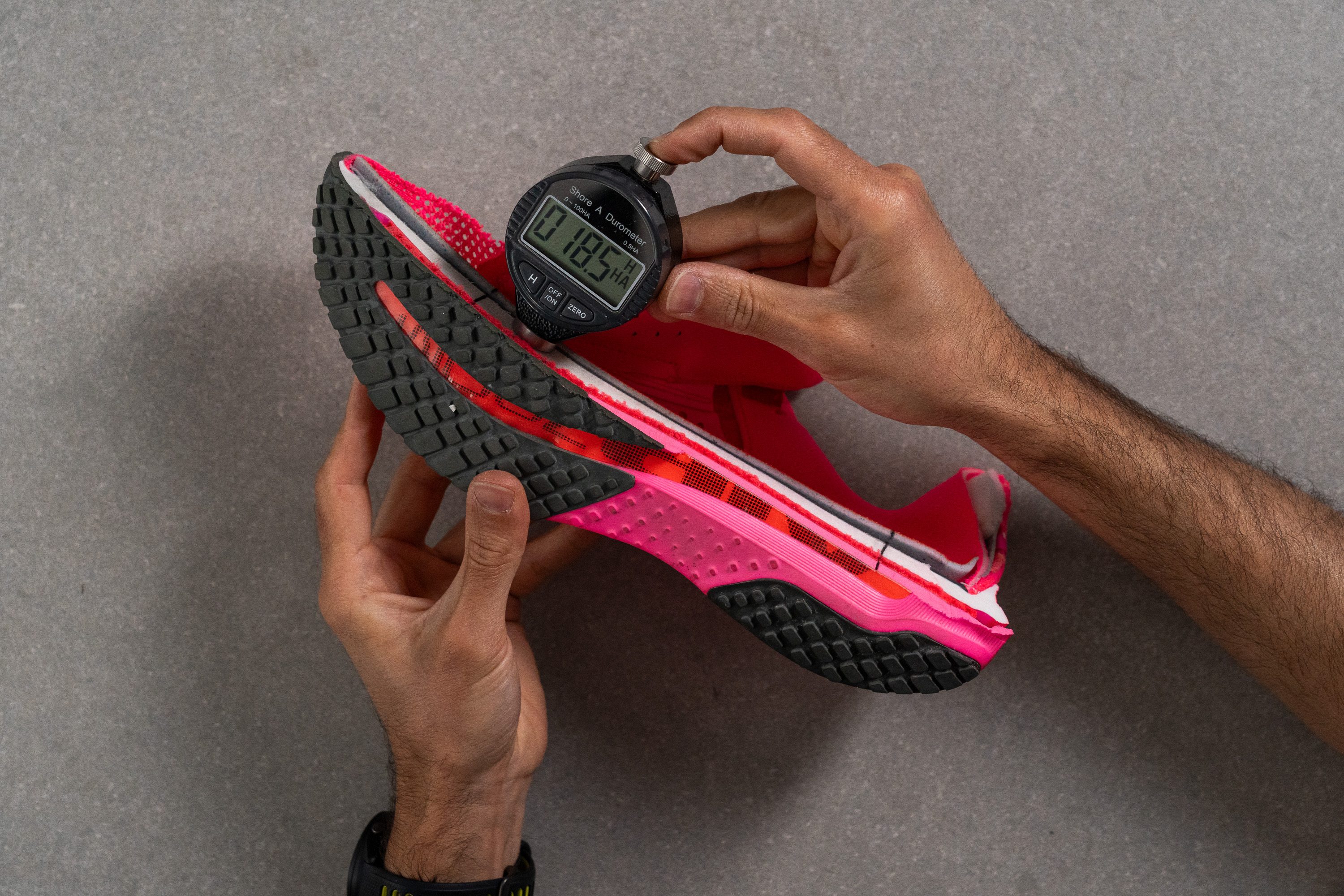
| Pegasus Premium | 18.5 HA |
| Average | 20.4 HA |
Secondary foam softness
ReactX is the layer that first absorbs impact from the ground. We measured it at 21.5 HA, which helps deliver a slightly more stable ride, something the Pegasus Premium clearly needs given its high-and-narrow geometry.
Still, we couldn't help but wonder if Nike could’ve gone full ZoomX here, especially considering the high price of this supertrainer.
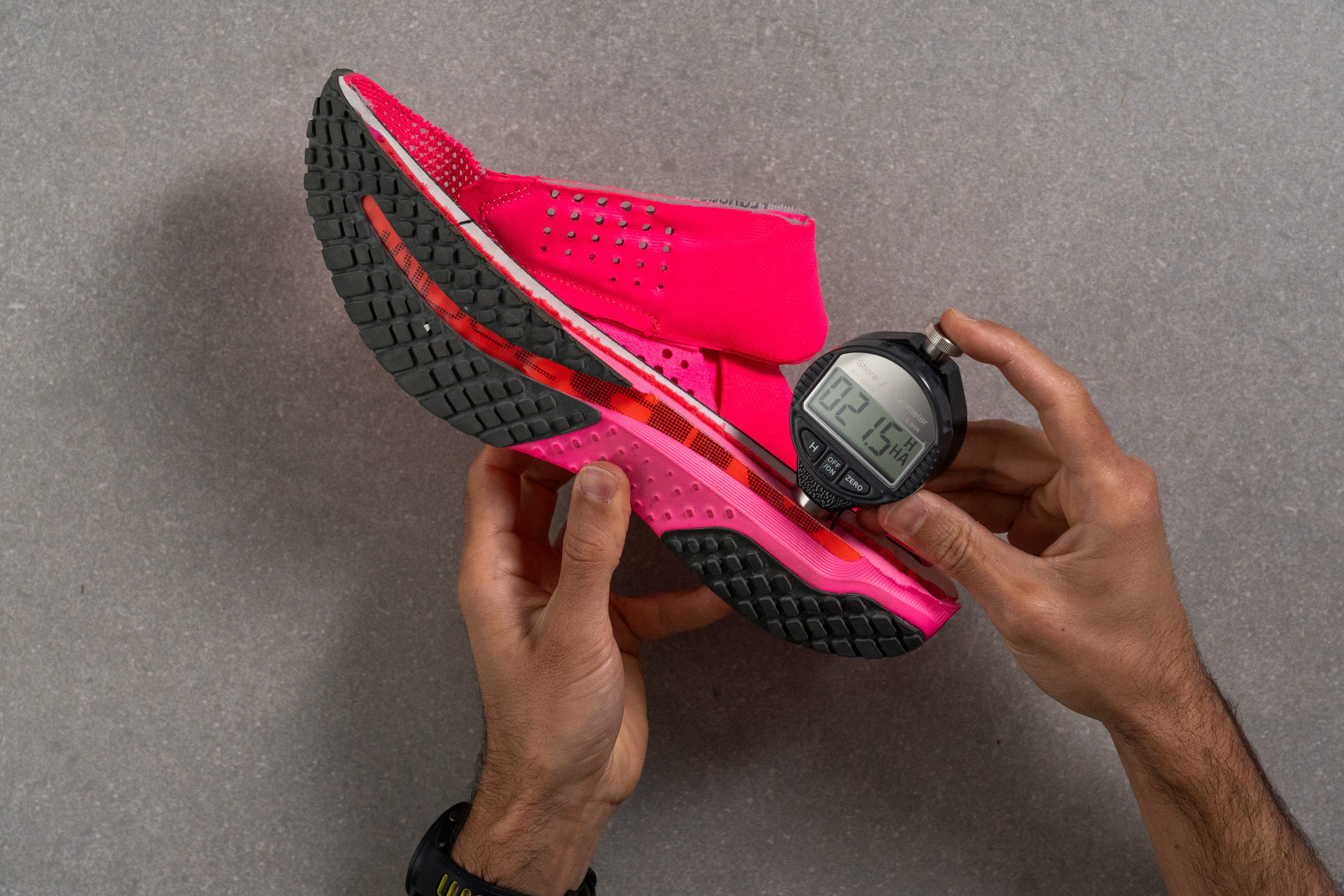
| Pegasus Premium | 21.5 HA |
| Average | 22.6 HA |
Rocker
Until now we’ve seen high-energy tech and a bounce-loaded midsole that place this shoe among Nike’s top performers. But during our review, we also noticed subtle cues suggesting it’s partly aimed at the lifestyle crowd.
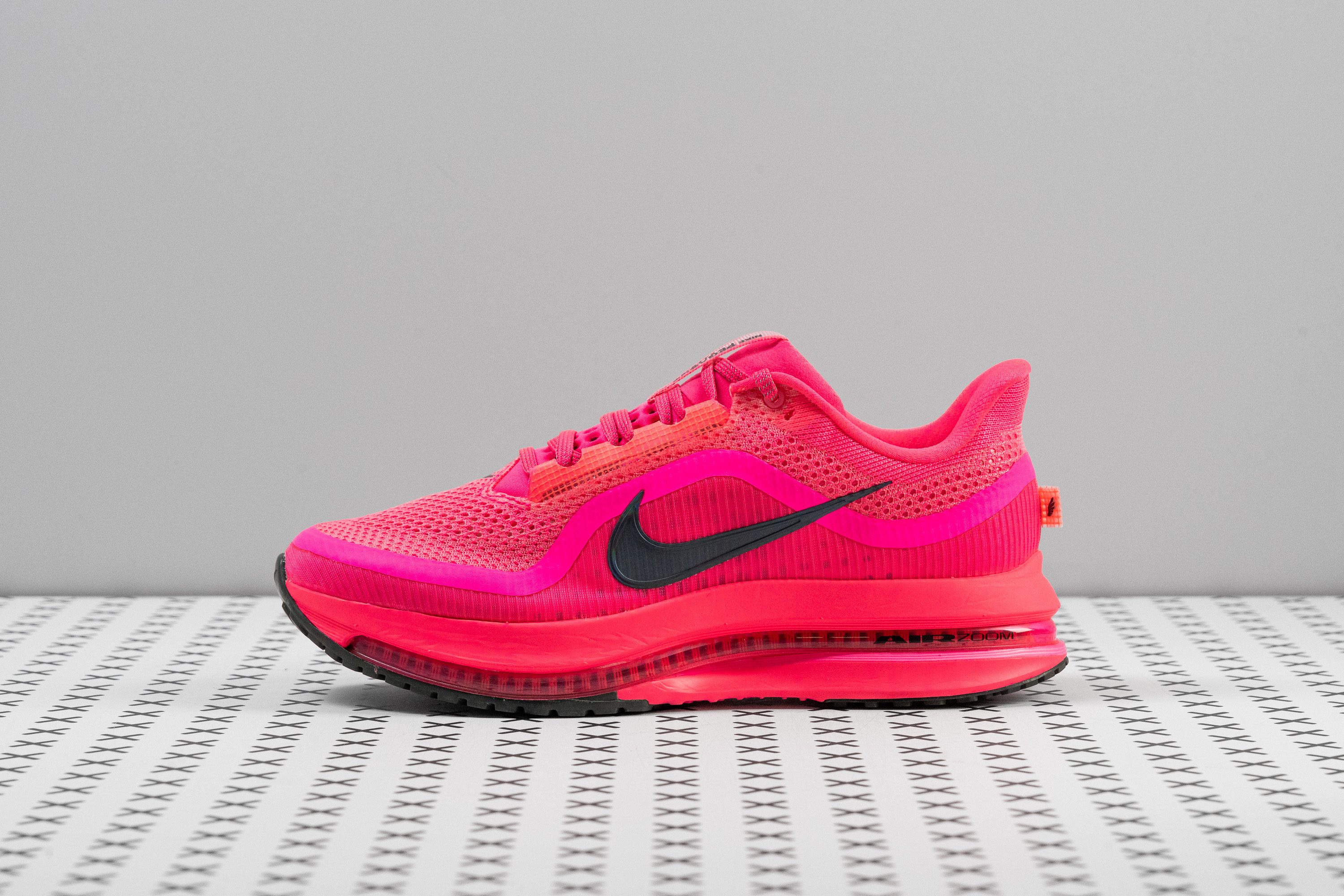
The rocker is surprisingly mild, especially in the heel, which caught us off guard given the sky-high stack and the usual rockered design of most max-stack supertrainers. Hence, those who prefer heavily-curved heel designs might struggle with this shoe.
However, it feels better than most competitors for walking thanks to its flatter shape—and just like what happened with the Adidas Ultraboost 1.0 turning into a super-popular casual sneaker, a sale’s a sale whether it’s for running or going to the supermarket.
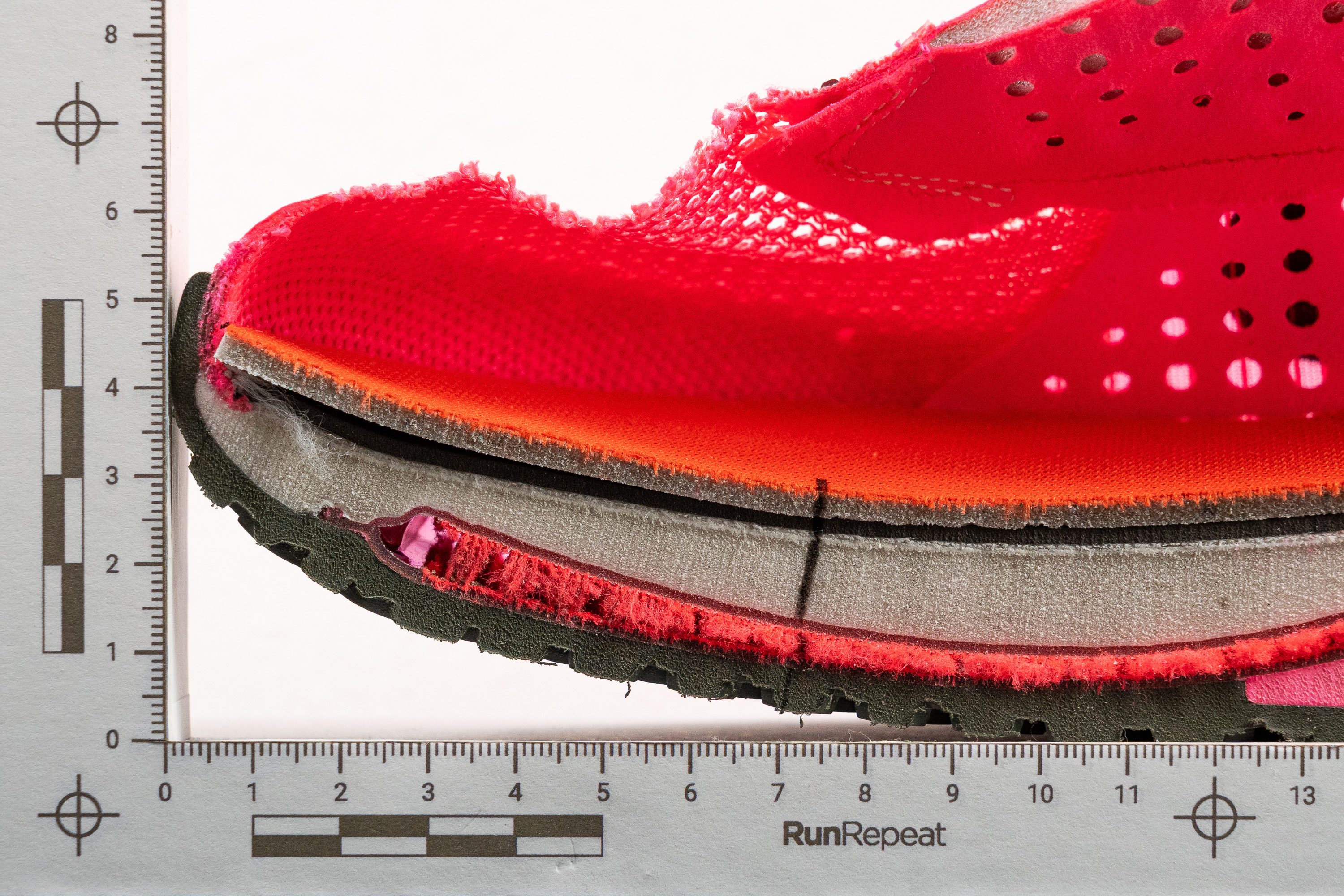
Air Zoom unit
The main innovation in this shoe is the full-length Air Zoom unit—it’s the first time Nike has used it in a running model, and it truly feels amazing underfoot. Think of the spring-loaded pods from the Alphafly 3, but extended from heel to toe.

Nike used it as a replacement for a carbon plate, shaping it with a spoon-like geometry and counting on the stiff ride this air-filled structure creates. We tested it and found it delivers a lively, high-bounce experience that feels like no other shoe in the market.
And please don't confuse this with the basic Air units used in models like the Nike Winflo 11. This is a top-tier thing with far more rebound—basically a stretched Alphafly pod running the length of the shoe. It’s a bold, forward-thinking move from Nike, and we’re convinced this will soon appear in other supershoes once they manage to trim down the weight.
Size and fit
Size
Nike Pegasus Premium fits slightly small (228 votes).
Width / Fit
During our runs, we noticed that the Nike Pegasus Premium felt far from spacious, so we headed to the lab to confirm it.
We made a 1:1 gel of the shoe and got a narrow 91.3 mm, backing up our first impression. This fit is a real win for runners with narrow feet, but makes the shoe a no-go for those needing extra room. We also confirmed there are no wide sizes available.
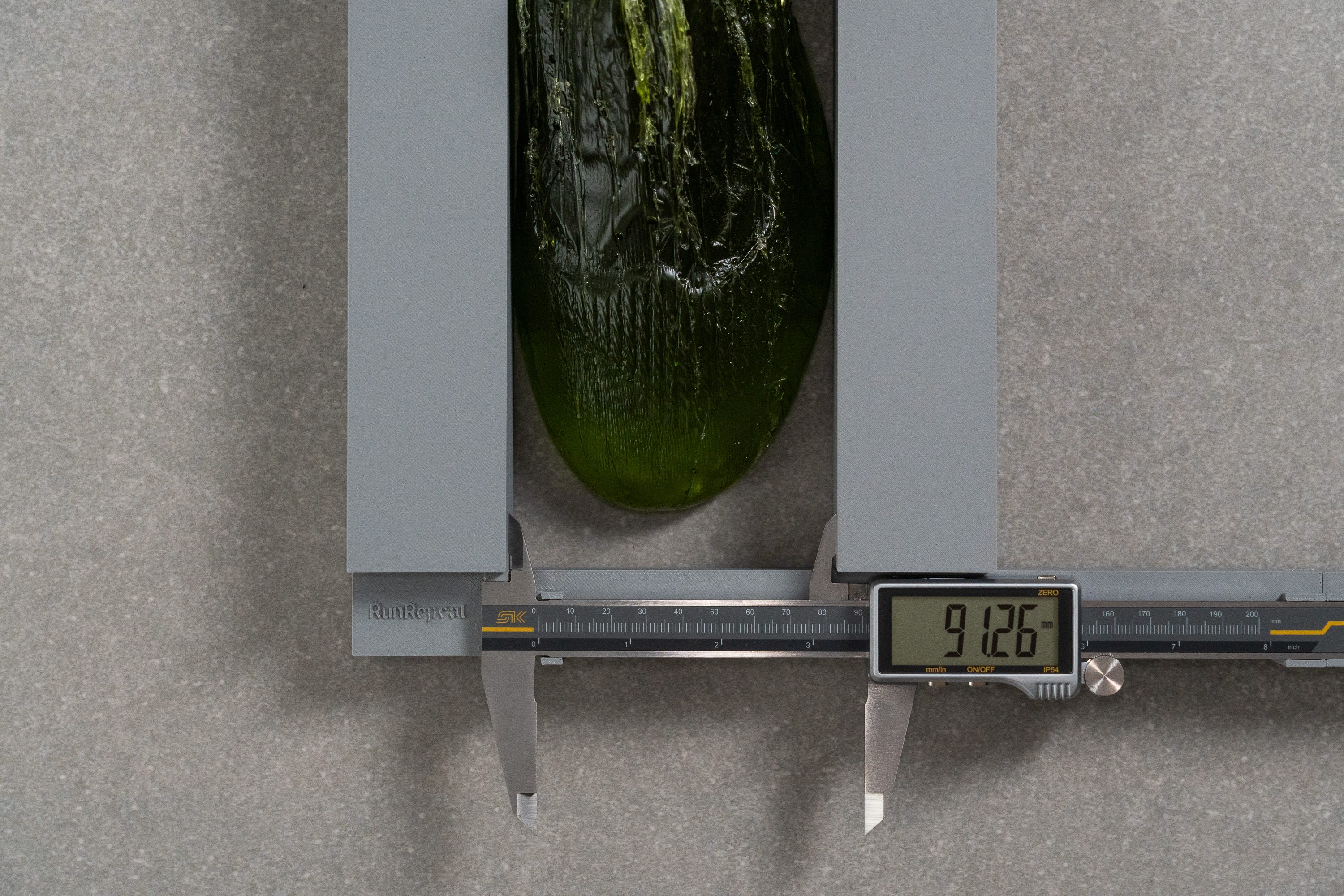
| Pegasus Premium | 91.3 mm |
| Average | 95.1 mm |
Toebox width
The Pegasus Premium features one of those classic-Nike tapered designs, with the toebox narrowing down to just 70.3 mm in our second measurement.
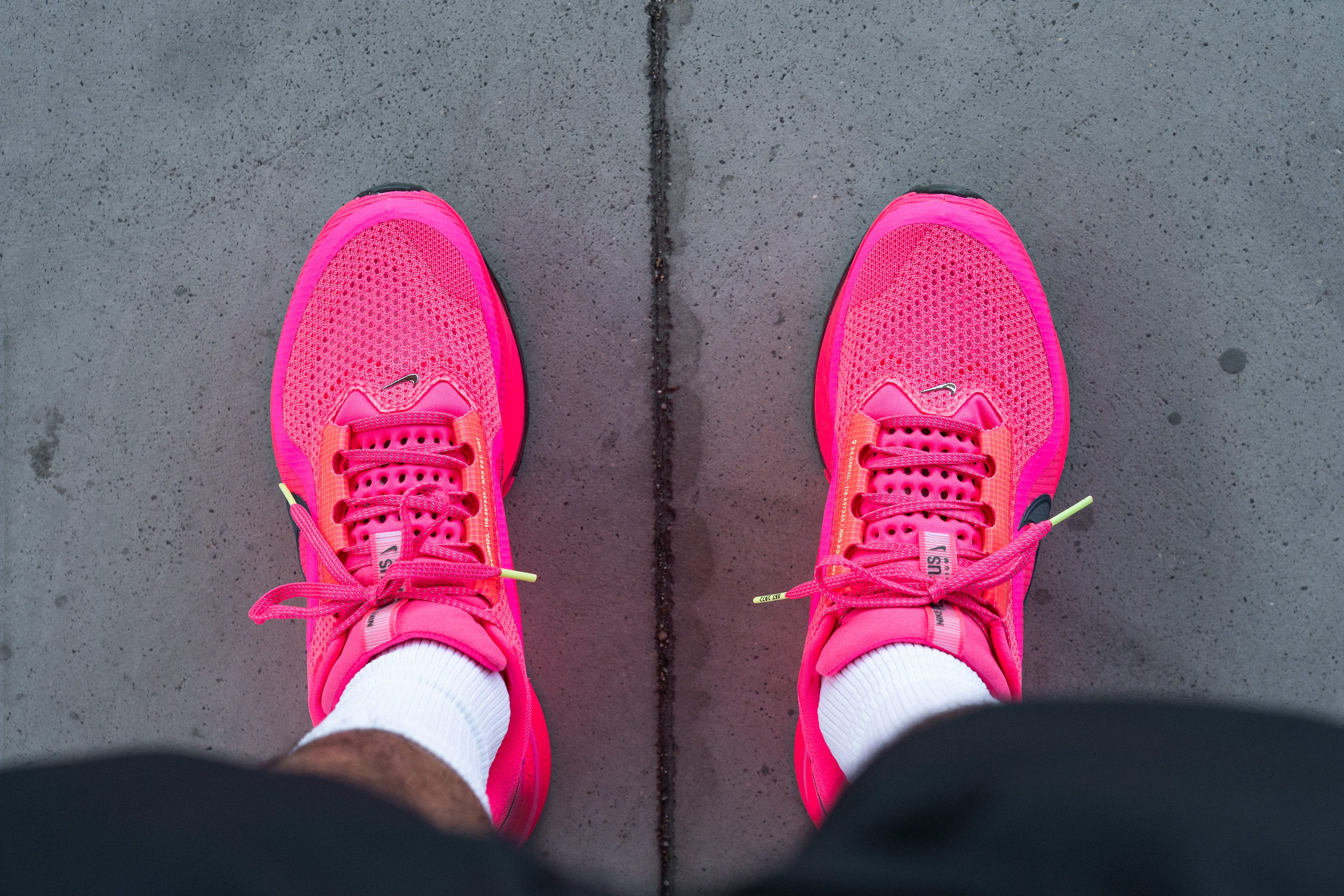
It’s a race-like shape that feels secure and snug, but it's not for everyone.
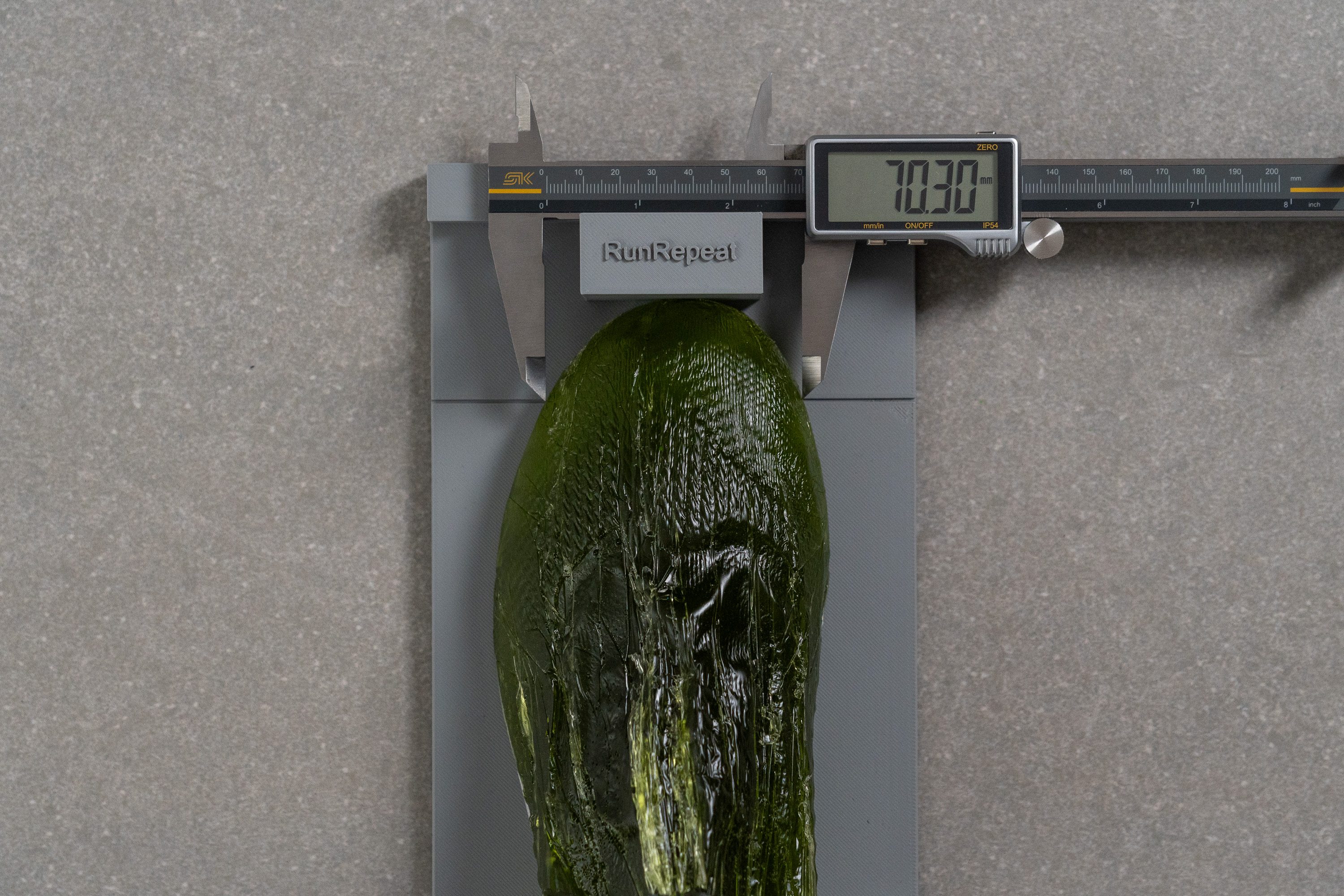
| Pegasus Premium | 70.3 mm |
| Average | 73.3 mm |
Toebox height
We found the vertical space in the toebox to be more than generous, with a knit-based upper that also gradually stretches and adapts. It never felt tight during testing—just the opposite as the previous two measurements.
Our calliper measurement confirmed this high-volume build at 29.1 mm.
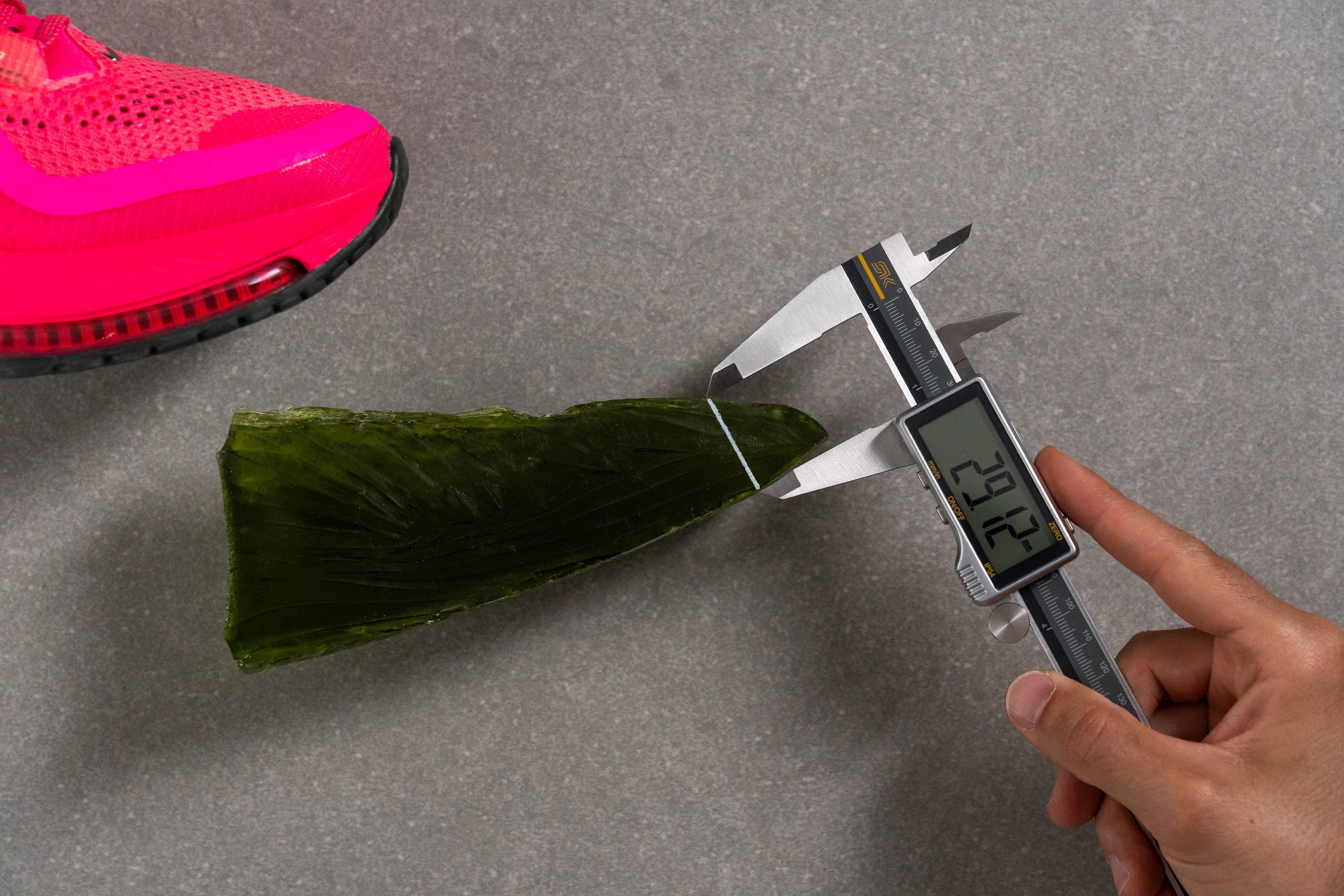
| Pegasus Premium | 29.1 mm |
| Average | 27.0 mm |
Traction / Grip
Traction test
We discovered during our traction test that the Pegasus Premium scored 0.49. That's decent grip on both dry pavement and wet roads.
However, Nike still trails behind rivals like Adidas and ASICS, whose top-tier outsoles are much grippier. We think that for a shoe priced above £200, this rubber performs fine but there's still plenty of room for improvement.
| Pegasus Premium | 0.49 |
| Average | 0.48 |
Outsole design
We found a two-zone rubber layout with dense diamond-shaped lugs in both the forefoot and heel, clearly built for high mileage as it features generous coverage in the forefoot. A sharp cutout runs through the centre, revealing the Air Zoom unit midsole and reducing weight.
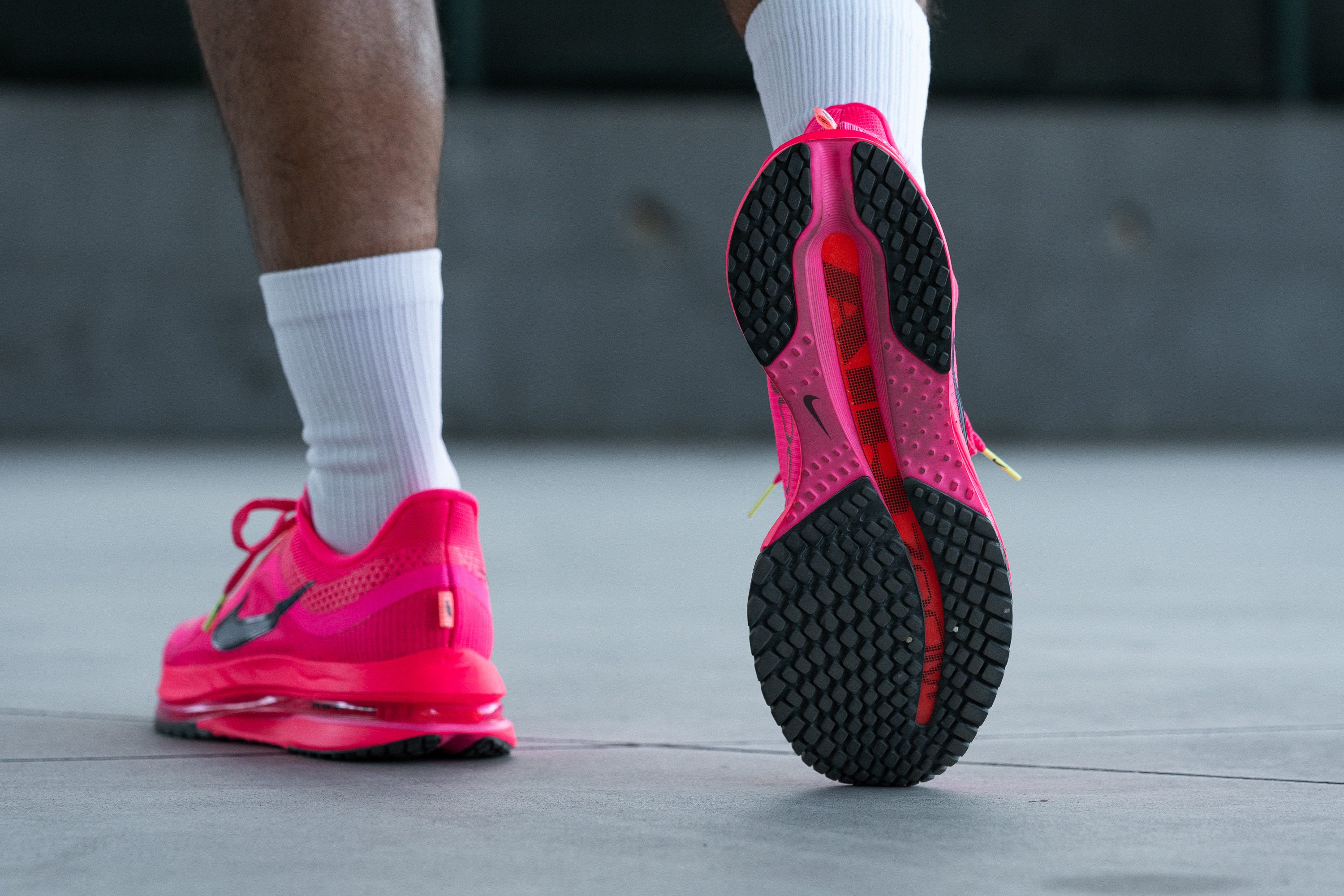
Flexibility / Stiffness
We locked the Pegasus Premium into our flex test machine and measured 21.2N, a high result that confirms what we expected. Basically, Nike clearly replaced the carbon plate with the full-length Air Zoom unit, as this score beats many plated supershoes.
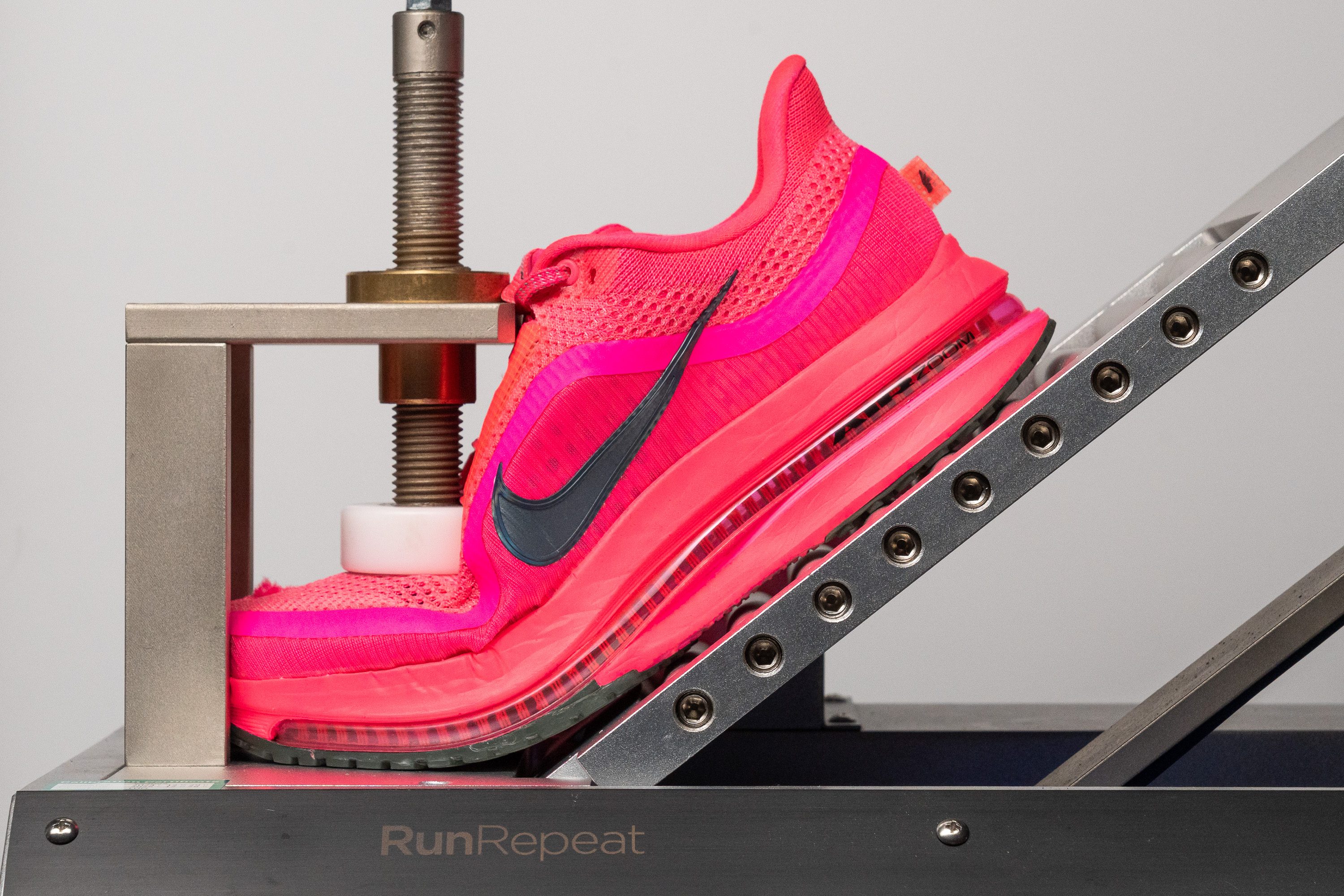
| Pegasus Premium | 21.2N |
| Average | 15.3N |
Weight
One of the less thrilling aspects of the Pegasus Premium is its weight. We tested it at 10.9 oz or 308g. That's noticeably heavier than most rivals.
This isn't a dealbreaker, but we think Nike needs to do a bit better here. A sub-10 oz design would unlock more versatility. Right now, it’s bouncy and fun, yet feels bottom-heavy—something we clearly noticed on faster efforts.
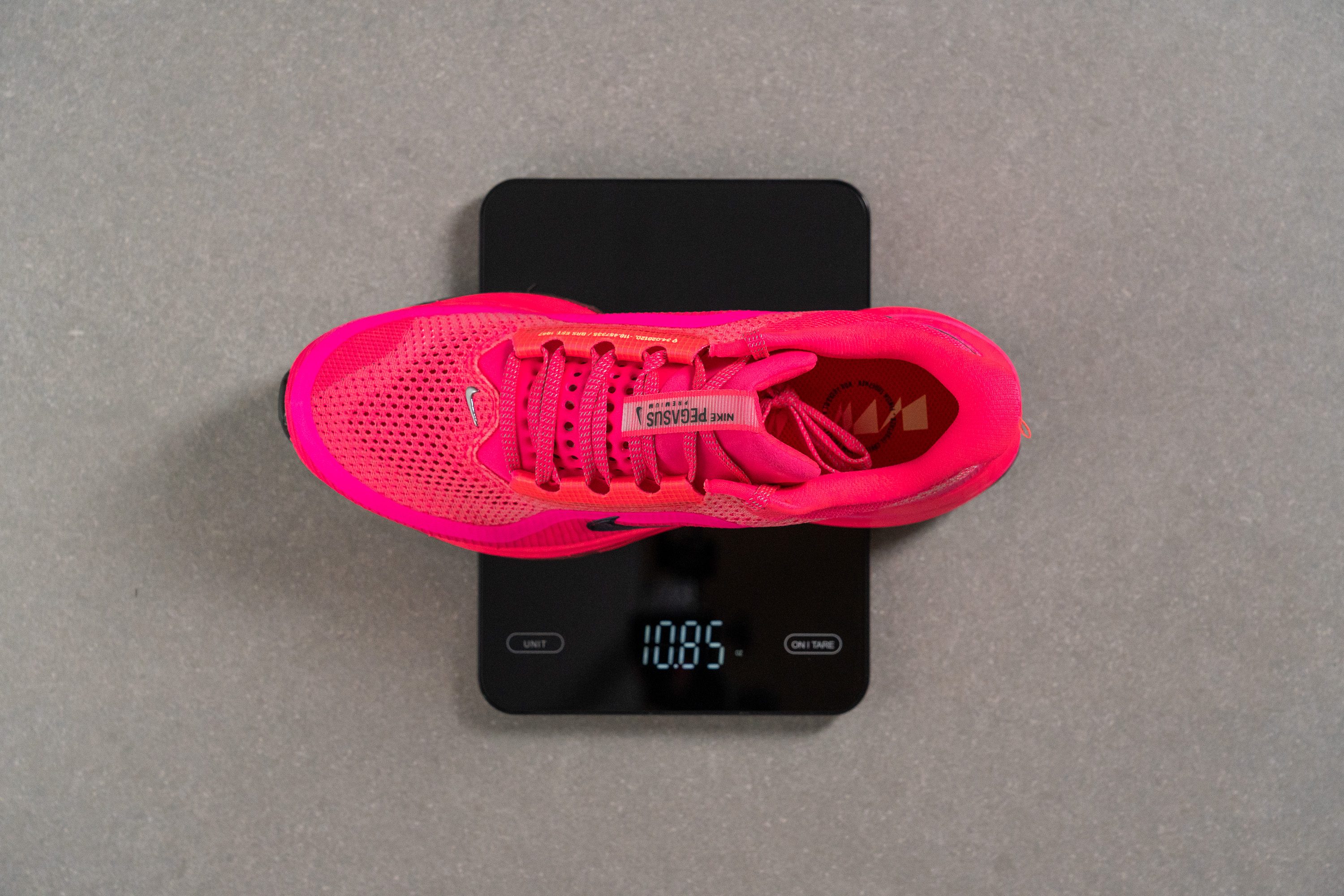
| Pegasus Premium | 10.9 oz (308g) |
| Average | 9.3 oz (264g) |
Breathability
The upper on the Pegasus Premium is one of the best we've ever seen here in the lab. Nike pulled off a knit-and-mesh combo that clearly sets this shoe apart from the crowd. The knit section wraps over the top for ultra-plush comfort, while mesh panels on the sides add structure and hold the foot securely in place.
It was time for our breathability test, and honestly, we knew what was coming the moment we saw the oversized holes in the toebox and tongue. When we ran our smoke test, it was an easy 5 out of 5.
Those giant openings in the midfoot and tongue are just wild—if your socks are white, they’ll definitely show. It’s the kind of airy-upper design that only a handful of shoes ever reach.
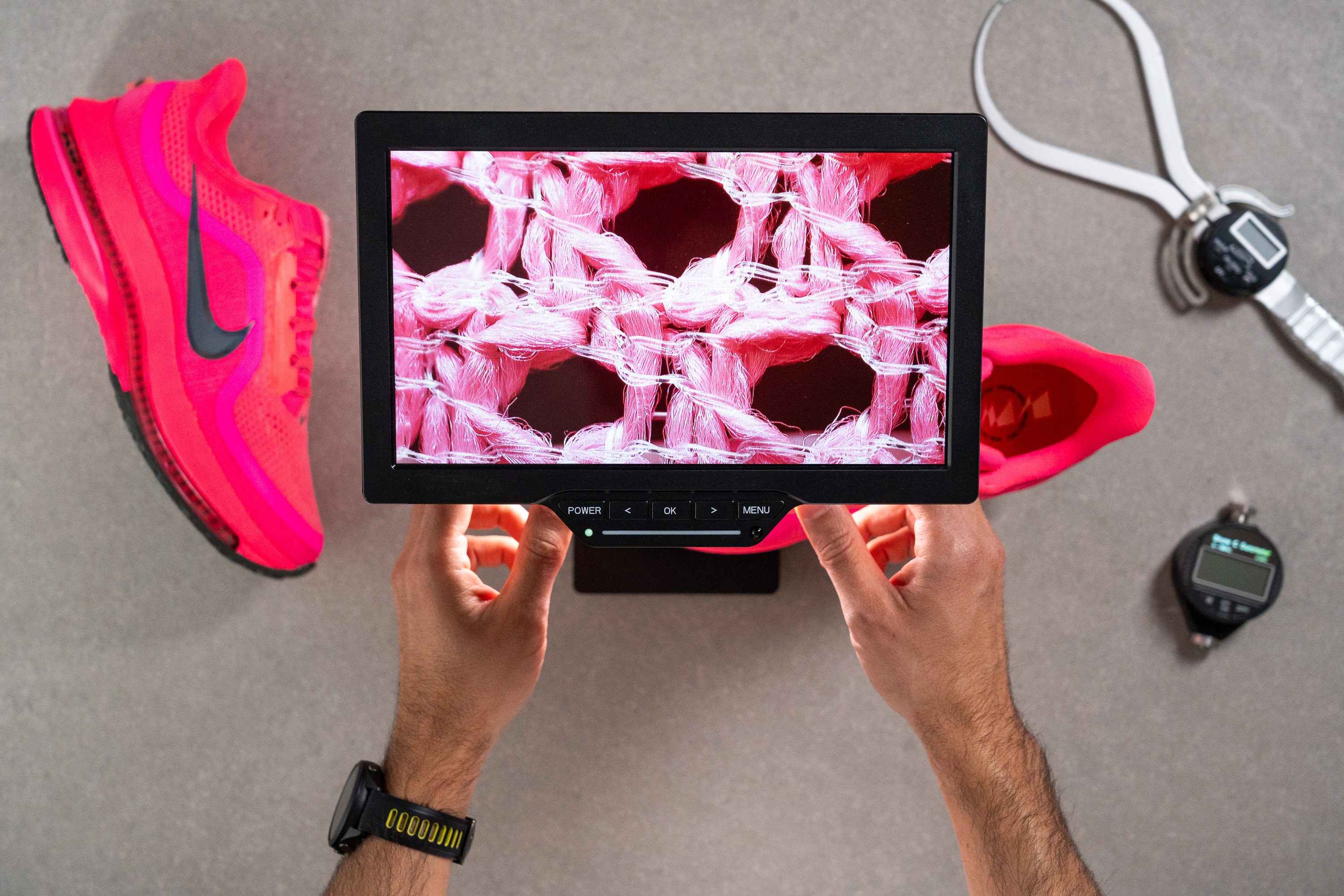
We then examined the material under our digital microscope. What we saw was a high-precision knit layout that shows how carefully Nike engineered every yarn—it’s both visually impressive and incredibly functional.
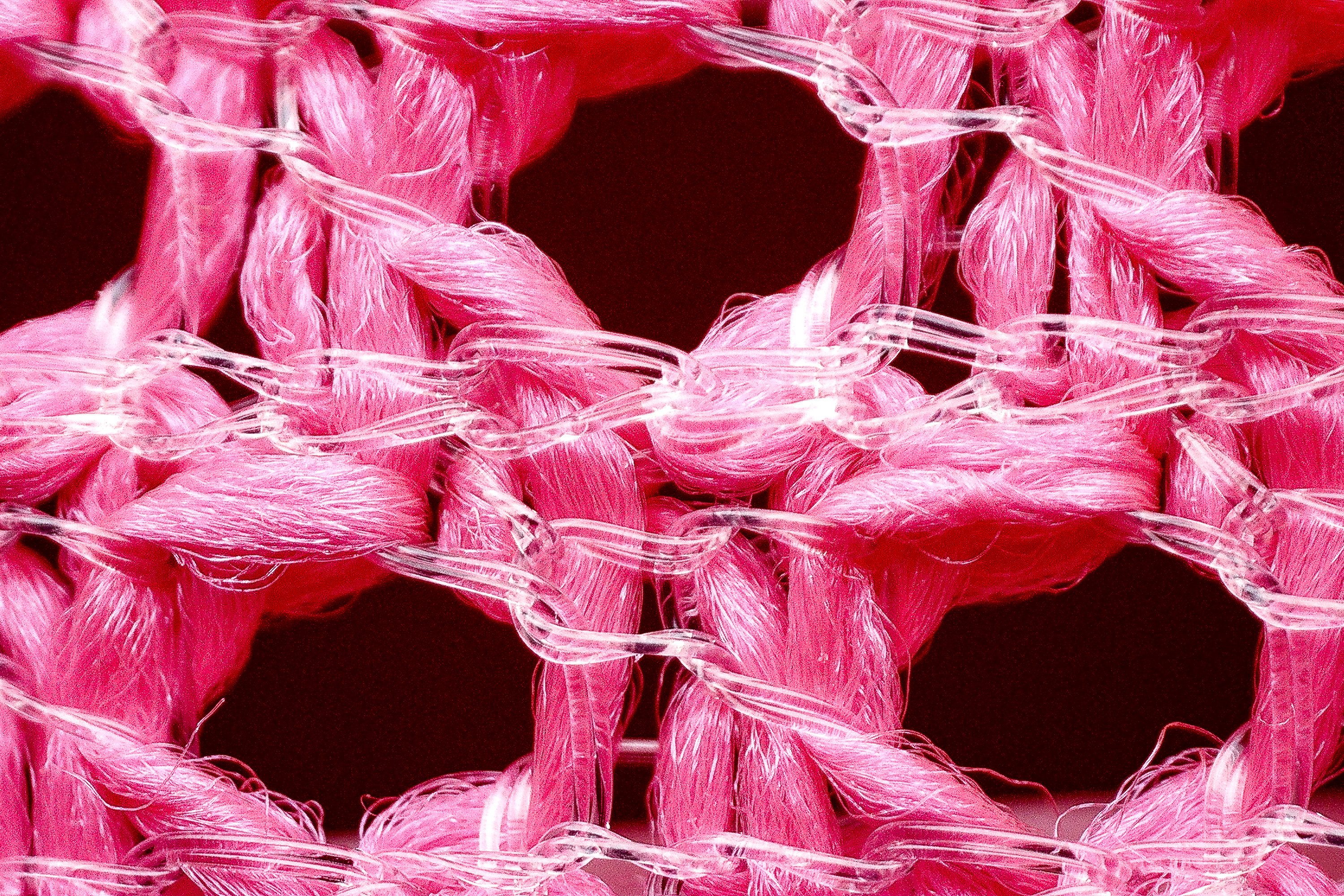
We found the padding in the heel and tongue generous—maybe even excessive. But if you’re into airy uppers crafted with premium materials and a first-class step-in feel, this shoe absolutely delivers.
| Pegasus Premium | 5 |
| Average | 3.7 |
Stability
Lateral stability test
The Pegasus Premium is a 100% neutral running shoe. It lacks traditional stability features and sits on a narrow platform, which can feel unstable for many—and extremely fun for others too, as the ride is far from autopilot and feels wild.
We found the midfoot extremely narrow, which can feel shaky for runners who need extra support. The stiff design helps a bit against wobbliness, and there’s a small sidewall and a centre groove in the outsole that help guide the foot a little. But again, we think that this shoe is only for runners with neutral form that don’t need any stability help.
Torsional rigidity
The full-length Air Zoom unit brings a serious boost in rigidity, hitting 4/5 in our manual test. That’s great news—without it, this ultra-tall shoe might’ve felt downright unmanageable.
| Pegasus Premium | 4 |
| Average | 3.5 |
Heel counter stiffness
Nike also built the heel counter to an ultra-stiff 5/5.
It’s not uncomfortable thanks to the thick, cushion-packed padding. But anyone who likes softer, more forgiving heel designs will likely dislike this shoe, as it locks the heel into a single-motion track.
| Pegasus Premium | 5 |
| Average | 2.9 |
Midsole width - forefoot
While most supertrainers go for ultra-wide, blocky platforms, we discovered that this one takes a different path at just 108.6 mm in the forefoot.
Maybe Nike aimed for a more nimble-and-playful ride, or maybe adding width would've made the shoe too heavy—we are not Nike designers so we don't know the ultimate reason behind this decision. What we can confirm is that it feels unlike most supertrainers. It’s less stable, especially in the midfoot, but noticeably more exciting underfoot—a rollercoaster-like feel that sets it apart from the crowd.
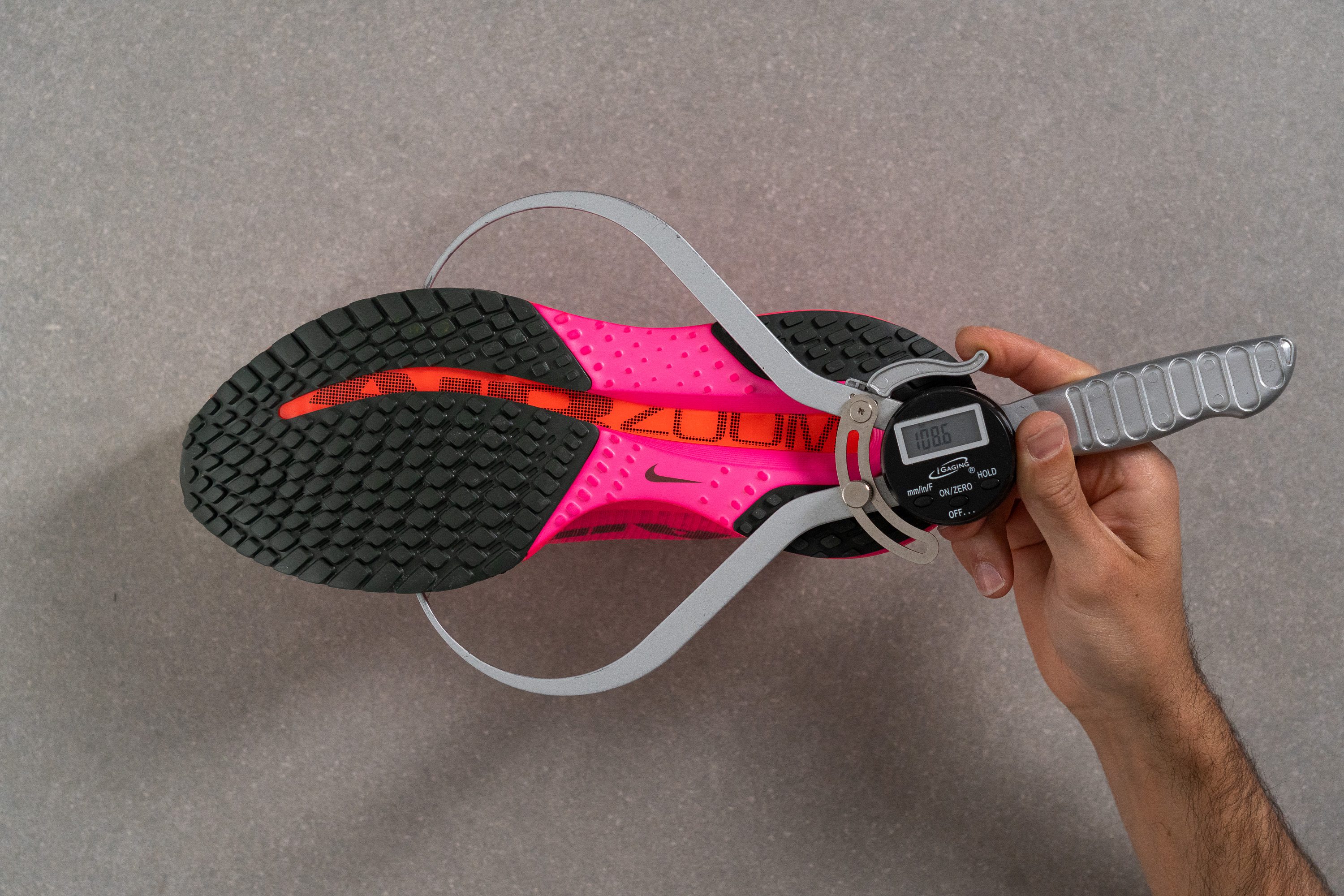
| Pegasus Premium | 108.6 mm |
| Average | 114.3 mm |
Midsole width - heel
The heel measures a more modest 90.3 mm, but considering the towering 40 mm stack, it still feels quite narrow and won’t suit runners needing rearfoot stability—unless you're picking it up as a casual sneaker, of course.

| Pegasus Premium | 90.3 mm |
| Average | 90.7 mm |
Durability
Toebox durability
Unfortunately, the oversized ventilation holes and ultra-soft knit material also mean durability takes a serious hit. Against our Dremel test, it performed poorly, scoring a disappointing 1/5.
| Pegasus Premium | 1 |
| Average | 2.6 |
Heel padding durability
We tested the heel padding with our Dremel and were surprised by its impressive resistance—it scored a flawless 5/5. That’s unusual for such ultra-cushioned design, which often trades durability for comfort.
| Pegasus Premium | 5 |
| Average | 3.4 |
Outsole durability
We already covered that the outsole grips well, but we can’t say it’s stellar—or even what you’d expect at this high price. As for rubber durability, Nike delivered the same story: a decent result, but nothing world-class, with 1.0 mm of wear.
Maybe it’s time for Nike to team up with a road-compound specialist—just like Adidas does with Continental. Are there any high-end tyre brands ready for a footwear colab?
| Pegasus Premium | 1.0 mm |
| Average | 1.1 mm |
Outsole thickness
If the rubber had been more wear-resistant, Nike could’ve slimmed the shoe down by using 1.5 or 2.0 mm instead of 3.2 mm.
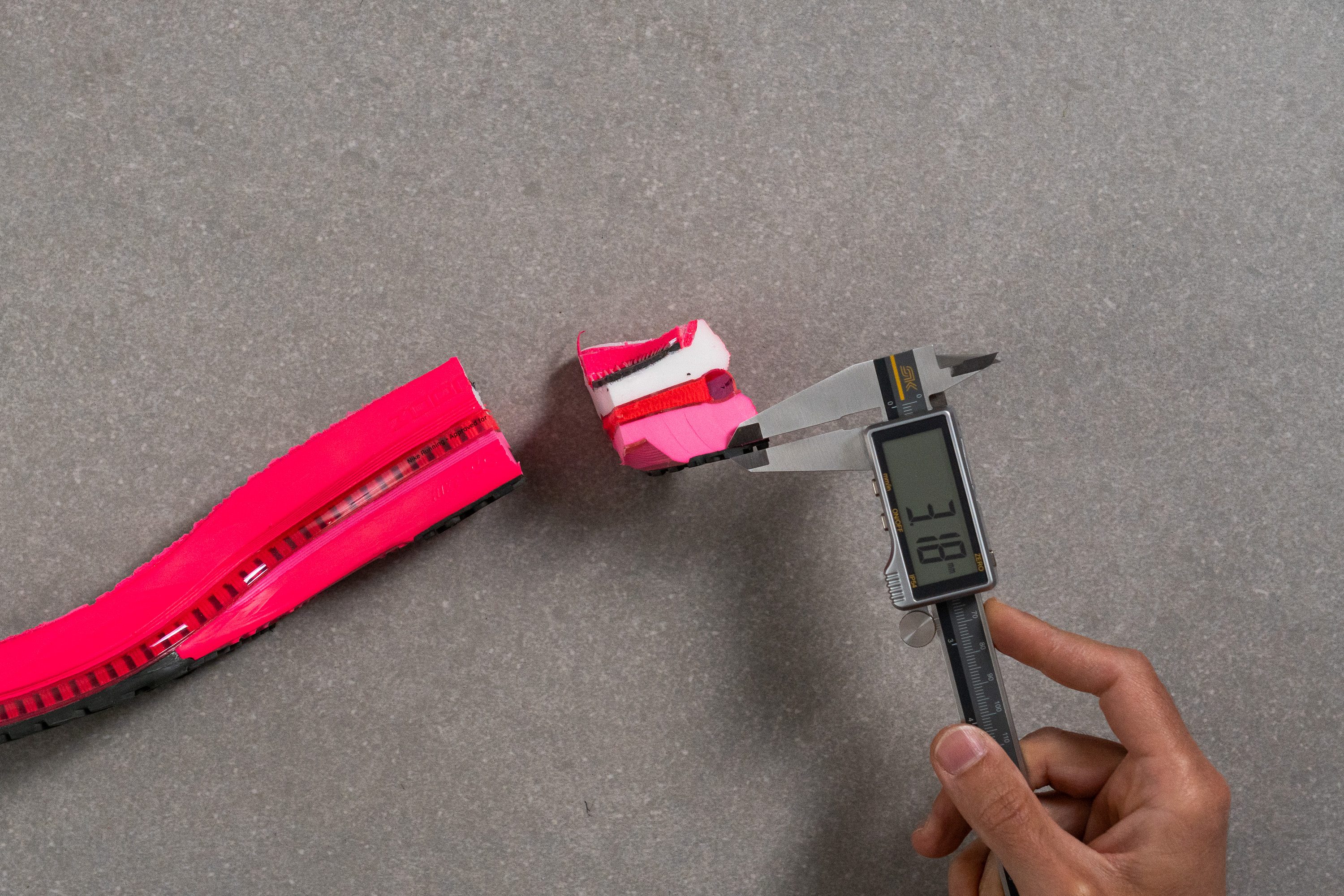
| Pegasus Premium | 3.2 mm |
| Average | 3.2 mm |
Misc
Insole thickness
At just 2.7 mm, the insole is thinner than what we usually see in Nike running shoes, likely because this high-stack model prioritises headline tech like ZoomX and the full-length Air unit.
Still, we think this was a missed chance to include a perforated insole crafted from a more performance-oriented material, something we think it's pretty reasonable from a shoe above the £200 mark.

| Pegasus Premium | 2.7 mm |
| Average | 4.5 mm |
Removable insole
The insole is removable and can be swapped with another, but keep in mind it’s quite thin—using a thicker one will reduce space in the already snug toebox.
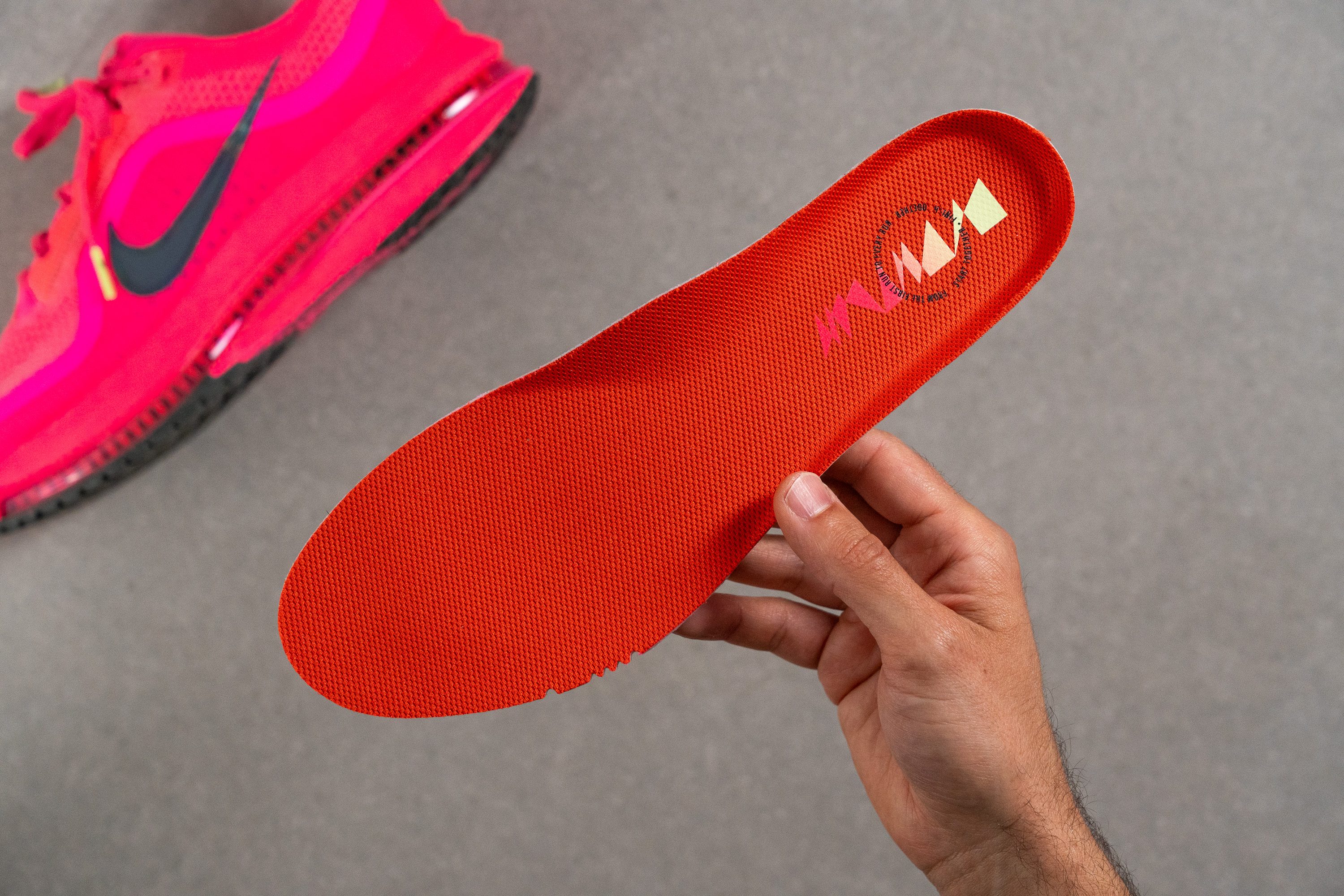
| Pegasus Premium | Yes |
Midsole softness in cold (%)
ZoomX is still made from Pebax, which means it performs incredibly well in cold conditions—firming up by only 8% after 20 minutes in our freezer.
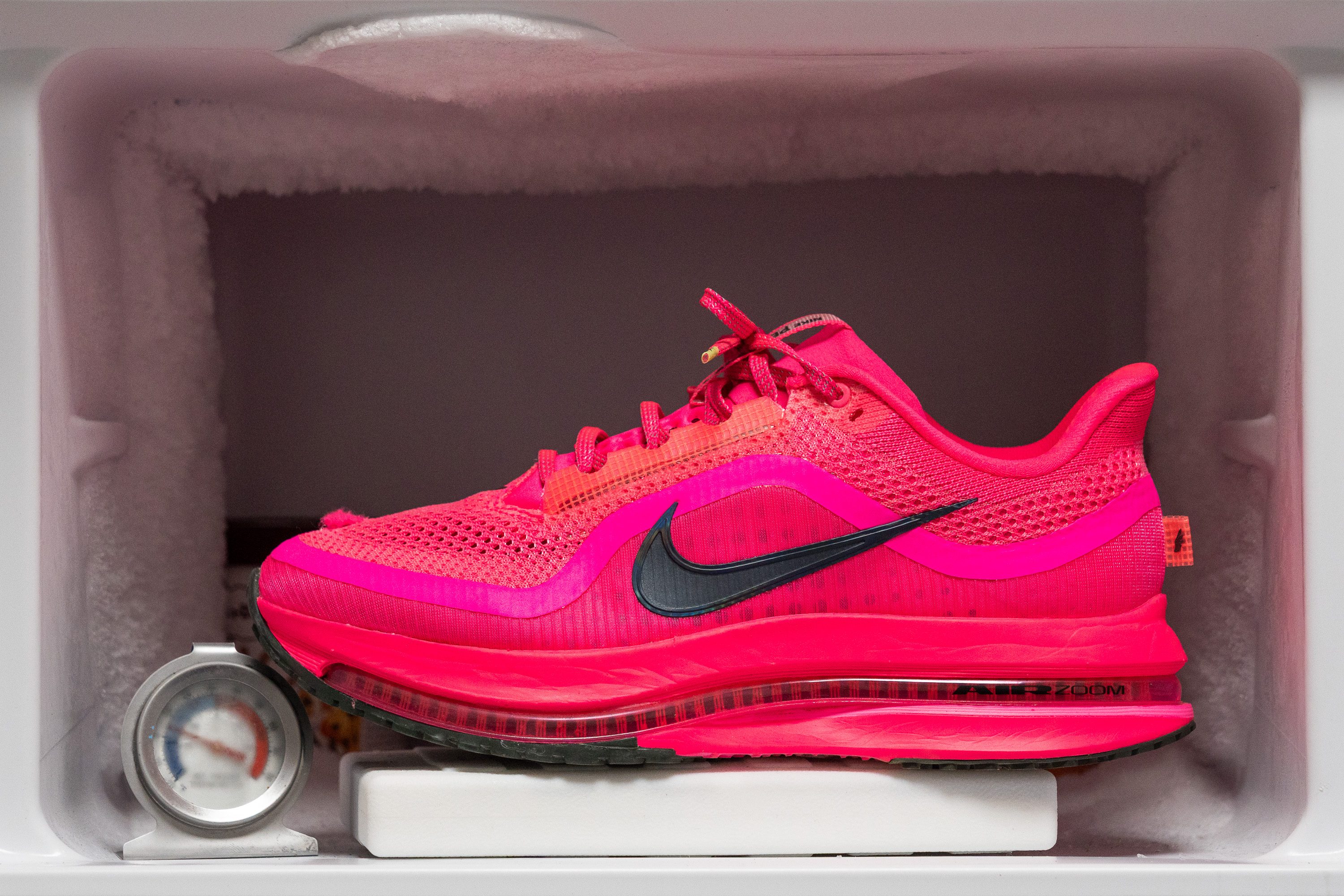
| Pegasus Premium | 8% |
| Average | 24% |
Reflective elements
We loved that Nike added full 360-degree reflectivity, as it's a cool feature that helps back up the premium price tag.
| Pegasus Premium | Yes |
Tongue padding
We had no complaints about the lacing system, as it feels solid and offers excellent adjustability. It was slightly odd to see the extra eyelet left unreinforced, but aside from that, it performs well and the laces are top-tier quality.
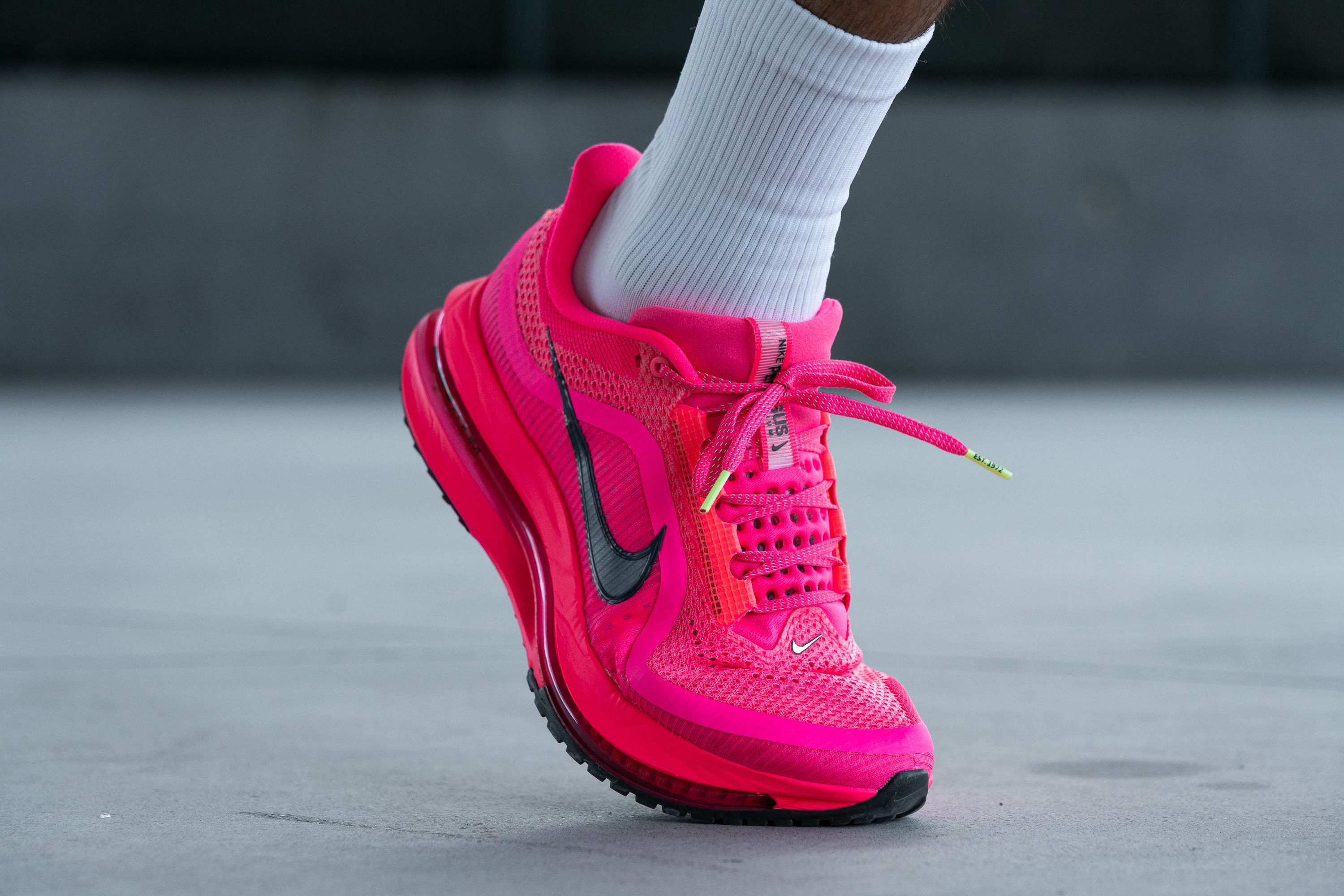
One of the key ingredients for an amazing and cloudy step-in feel relies in the tongue. And Nike decided that for the Pegasus Premium, comfort is a priority.
That's the only way to explain that this shoe features 9.9 mm of padding in the tongue, a measurement that's more common of comfort-oriented daily running shoes. On the other hand, supertrainers that are focused on performance usually come with less than half of that, with some models boasting razor-thin tongues.
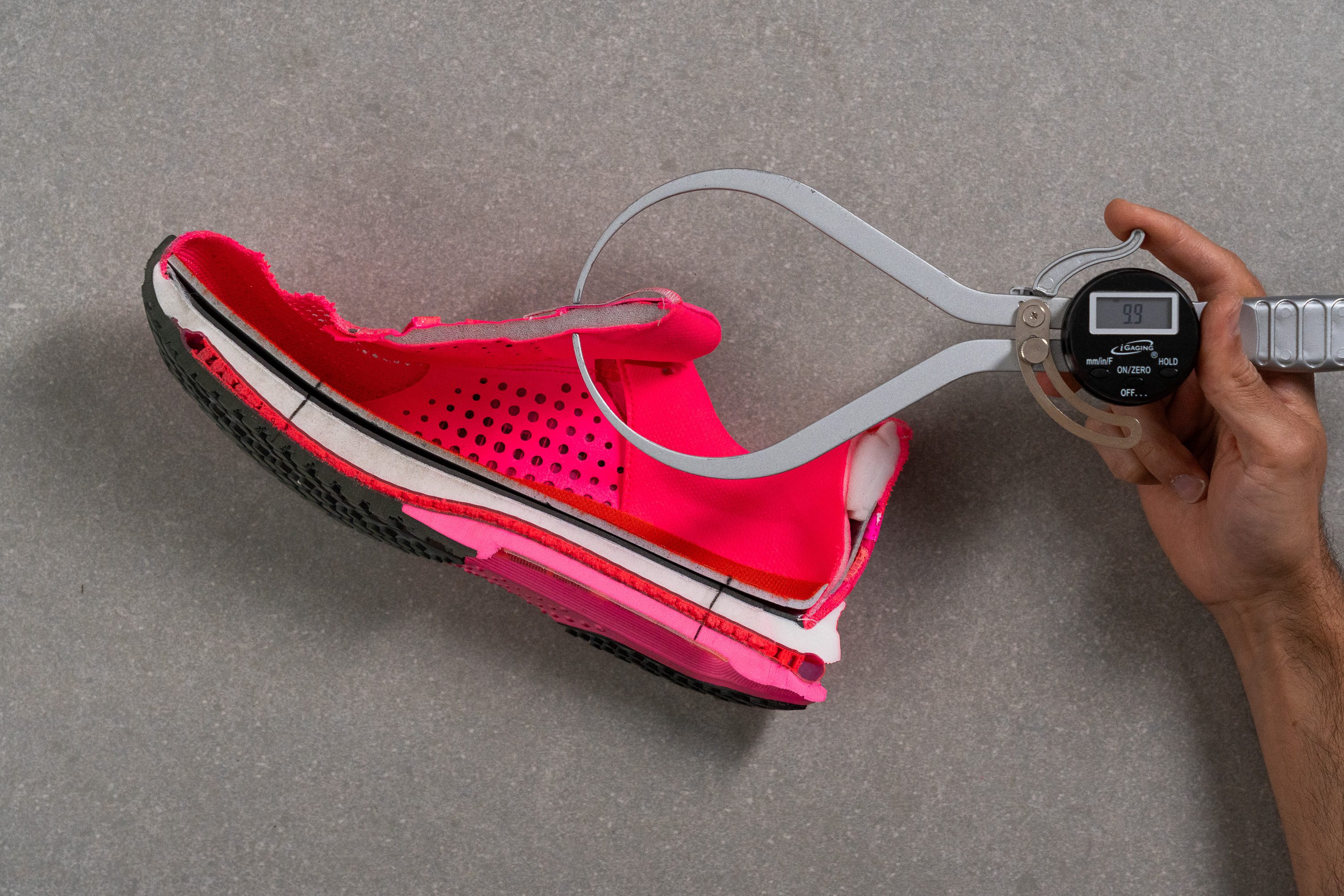
| Pegasus Premium | 9.9 mm |
| Average | 5.8 mm |
Tongue: gusset type
One of the biggest letdowns in the shoe is the absence of a gusseted tongue.
Yes, the thick-and-cushy tongue helps by letting us cinch the laces without discomfort, and the central tongue loop helps quite a bit too. But...
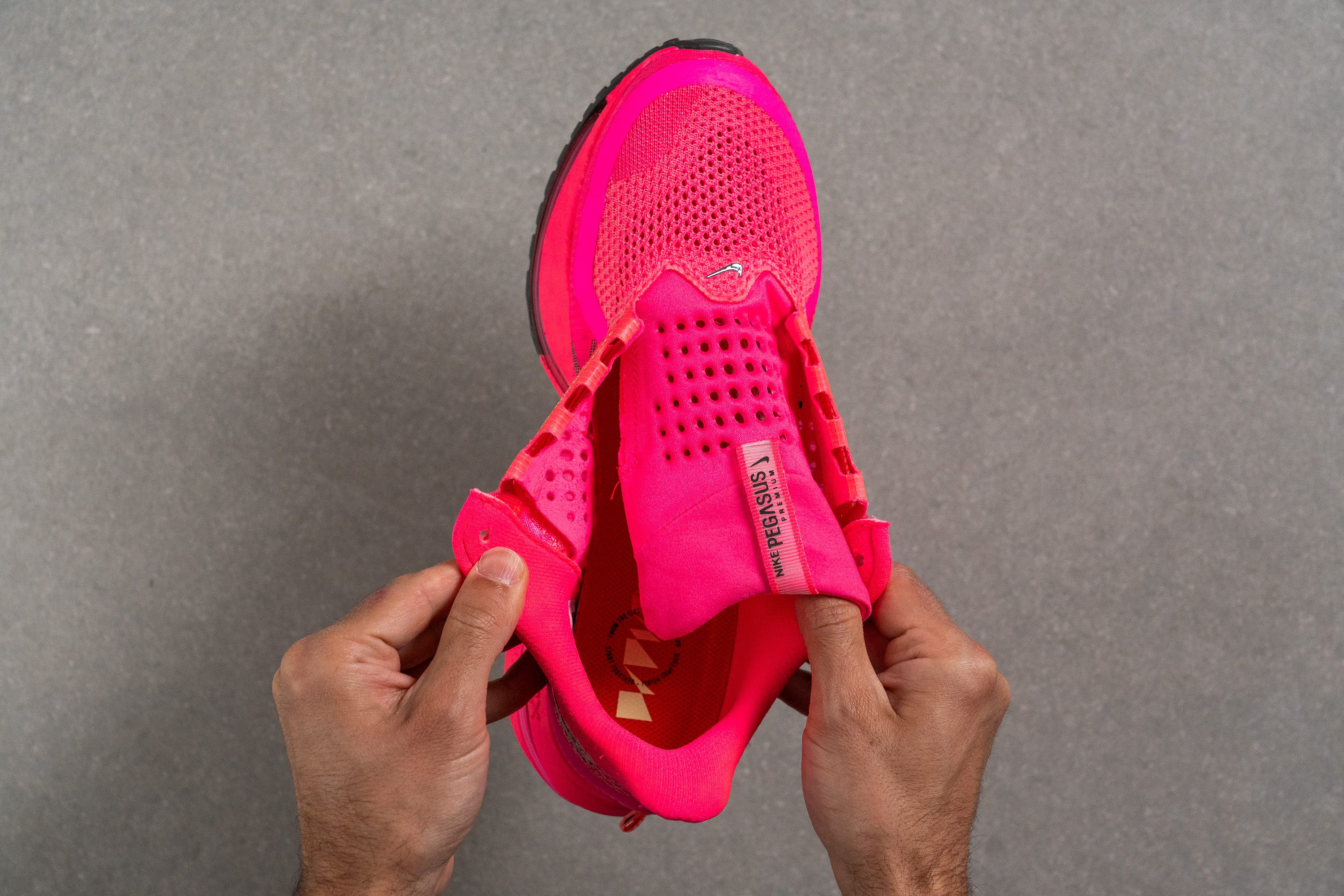
| Pegasus Premium | None |
Price
The Nike Pegasus Premium, as the name implies, belongs to the higher tier of the Pegasus line and comes with a steep price—especially considering its limited versatility. Those who appreciate high-end materials may find it worth it, but for many runners, the cost will be excessive.
| Pegasus Premium | $210 |
Heel tab
The heel includes an extended collar design that makes it easier to pull the shoe on and slightly reduces pressure on the Achilles tendon.
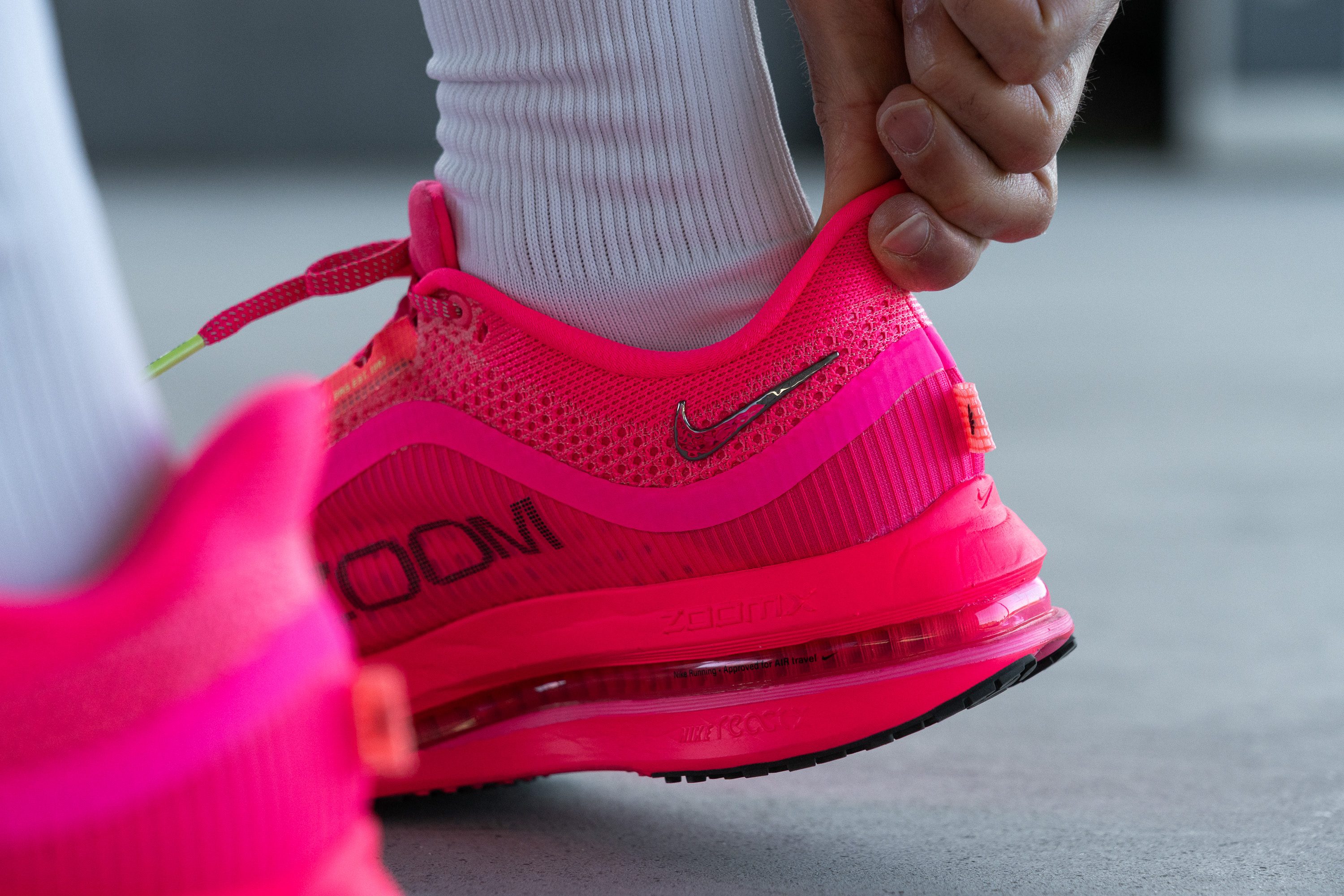
| Pegasus Premium | Extended heel collar |

